A Study on the Evolution of Lightscapes in the Beijing Road Historic and Cultural Zone, Guangzhou, China
Abstract
1. Introduction
2. Historical Lightscape and Construction Characteristics of the Beijing Road Historic and Cultural Zone
2.1. Natural Lightscape
2.1.1. The Pearl River in the Area of Tianzi Wharf
2.1.2. Haishan Tower

2.1.3. Taiping Yanhu (A Scenic Beauty)
2.1.4. West Lake and Yaozhou (An Islet)
2.1.5. Summary of Natural Lightscape
2.2. Artificial Lightscape
2.2.1. Jasmine Lantern
2.2.2. Shop Lamps and Lanterns
2.2.3. Night Market Lighting
2.2.4. Lightscape of the Academy
2.2.5. Lightscape of Official Activities at Tianzi Wharf
2.2.6. Summary of Artificial Lightscape
2.3. Folk Lightscape
2.3.1. Dragon Boat Race
2.3.2. Lantern Festival
2.3.3. Birthday of the Lord Huaguang
2.3.4. Lightscape of Flower Market
2.3.5. Summary of Folk Lightscape
3. Existing Lightscape and Construction Characteristics of the Beijing Road Historic and Cultural Zone
3.1. Natural Lightscape
3.1.1. The Pearl River in the Area of Tianzi Wharf
3.1.2. West Lake and Yaozhou Site
3.1.3. Light and Shadow of Buildings and Structures
- (1)
- Light and shadow on the Department of Finance of Guangdong Province Building
- (2)
- Light and shadow on arcade buildings in a street of time-honored shops
3.1.4. The Site of the Ruins of Time-Honored Beijing Road and Gongbei Tower
3.1.5. Summary of Natural Lightscape
3.2. Artificial Lightscape
3.2.1. Lightscape of Lamps and Lanterns
3.2.2. Lightscape of Building Lighting
- (1)
- Lightscape of the Grand Buddha Monastery at night
- (2)
- Lightscape of Department of Finance of Guangdong Province Building at night
- (3)
- Lightscape of arcade buildings in a street of time-honored shops at night
3.2.3. Lightscape of Multimedia Technology
- (1)
- Xin Da Xin Department Store naked-eye 3D curved screen
- (2)
- Holographic dynamic projection
- (3)
- Facade projection of arcade building in the street of time-honored shops
3.2.4. Lightscape of Landscape Lighting
- (1)
- The site of the ruins of time-honored Beijing Road and Gongbei Tower
- (2)
- Copper Kettle Clepsydra
- (3)
- New Flower Street
3.2.5. Summary of Artificial Lightscape
3.3. Folk Lightscape
3.3.1. The Folk Custom of “Flower Street” and the Spring Festival Flower Market
3.3.2. Guangfu Temple Fair
3.3.3. Summary of Folk Lightscape
4. Comparison of Ancient and Modern Lightscape
4.1. The Type of Natural Lightscape Has Changed
4.2. The Expression of Artificial Lightscape Has a New Form
4.3. Folk Lightscape Is Still an Important Part of Traditional Culture
5. Conclusions
6. Future Work and Discussion
6.1. Recommendations and Strategies
- (1)
- For vanished lightscapes, digital reconstruction technologies, including multimedia restoration of historical photographs and paintings, provide viable revival solutions. This approach demonstrates a significant potential through the integration of 3D modeling techniques, which enable the transformation of historical lightscapes into dynamic visual representations. Such technological applications substantially enhance visitor engagement by delivering immersive experiences, particularly through augmented reality (AR) systems that permit the overlay of virtual historical scenes onto physical environments via mobile devices. Compared to physical conservation methods (e.g., architectural reconstruction), digital restoration exhibits considerable advantages in terms of cost-effectiveness and unlimited reproducibility. Nevertheless, several limitations warrant consideration: the reconstruction quality is inherently dependent on source material integrity, while AI algorithms frequently produce aesthetically optimized outputs that may compromise historical accuracy. Furthermore, virtual reality (VR) implementations risk fostering misinterpretations among viewers who might perceive reconstructions as factual historical records, potentially leading to cognitive dissonance.
- (2)
- For extant historical lightscapes, it is necessary to implement enhanced conservation and transmission measures. Regarding contemporary lightscape manifestations, innovative integration with Guangfu cultural elements can effectively showcase regional distinctiveness. Specifically, the interactive lightscape installations incorporating Guangfu cultural motifs could be developed, serving dual purposes of fostering public engagement and promoting cultural awareness.
- (3)
- Regarding sustainable lighting design, the historical lightscapes of the Beijing Road historic and cultural zone represent a key cultural asset that can support sustainable development initiatives. When implementing illumination schemes, dual consideration must be given to visitor requirements in historic and cultural zones and ecological preservation [68]. Advanced solutions like motion-activated lighting systems can minimize light pollution while preserving distinctive nocturnal ambience and reducing energy expenditure. Particular attention should be devoted to preventing the urban nightscape homogenization caused by standardized lighting practices [69], with the prioritized conservation of regionally characteristic luminous heritage. These cultural assets not only embody the historical continuity of Guangzhou but also serve as crucial resources for urban sustainability, requiring innovative approaches that balance preservation with progressive development.
6.2. Future Work
- (1)
- A lightwalk methodology integrated with questionnaire surveys will be implemented to assess subjective perceptions. This approach, as a specialized form of sensory walk, involves a systematic pedestrian-based evaluation of luminous environments through predetermined routes [70]. Researchers will first identify critical spatial nodes—including high-density pedestrian areas and culturally significant landmarks—through preliminary field studies to establish optimized assessment paths. During implementation, trained facilitators will guide the participants along designated routes, with structured pauses at predetermined observation points for independent environmental evaluation. The participants will subsequently complete standardized questionnaires documenting their lightscape experiences both at observation nodes and along transit paths.
- (2)
- Objective environmental measurements. A quantitative assessment of the photometric parameters in the lightscapes on Beijing Road will be conducted, including luminance distribution, correlated color temperature, and horizontal illuminance. High dynamic range (HDR) imaging technology will be systematically employed for comprehensive light environment analysis, following established protocols for urban lighting research.
- (3)
- Laboratory simulation studies. On-site captured images will be replayed in the laboratory for participants to evaluate. This approach integrates eye-tracking, electrocardiogram (ECG), and galvanic skin response (GSR) measurements to analyze human perception of light environments.
Author Contributions
Funding
Data Availability Statement
Acknowledgments
Conflicts of Interest
References
- Wu, S. Main Points of Lightscape. South Archit. 2017, 3, 4–6. [Google Scholar] [CrossRef]
- Qiu, J.; Wu, S. Lightscape and Architecture. Archit. J. 2017, 115–118. [Google Scholar]
- Qiu, J.; Li, J.; Li, Y.; Wei, T. Research Progress on Multi-Landscapes From Multi-Dimensional Perception Perspective. J. Huaqiao Univ. Nat. Sci. 2024, 45, 445–453. [Google Scholar] [CrossRef]
- Wu, S.; Qiu, J. “Reading”, “listening” and sound, light environment. City Built Environ. 2024, 2, 1. [Google Scholar] [CrossRef]
- Lu, Y.; Su, X.; Wu, S.; Gao, W. Interpretation and Expansion of the 100 Smellscapes of Japan. South Archit. 2022, 55–59. [Google Scholar]
- Qiu, J.; Kang, J.; Wu, S. Progress of Soundscape Research and Practice in Europe. Chin. Landsc. Archit. 2022, 38, 58–63. [Google Scholar] [CrossRef]
- Gazette of the People’s Government of Guangzhou Municipality. Notice of the General Office of the People’s Government of Guangzhou Municipality on Issuing the “14th Five-Year Plan” for Ecological Environmental Protection in Guangzhou; Gazette of the People’s Government of Guangzhou Municipality: Guangzhou, China, 2022; pp. 1–56. [Google Scholar]
- Yuan, X.; Qiu, J.; Chen, Y.; Wu, S. A Summary of the Academic Achievements of South China University of Tech. Team on “Trio-scape”. South Archit. 2022, 5–18. [Google Scholar]
- Li, Y.; Wu, S.; Qiu, J.; Wei, T. Sustainable University Campuses: Temporal and Spatial Characteristics of Lightscapes in Outdoor Spaces. Sustainability 2024, 16, 7355. [Google Scholar] [CrossRef]
- Xu, M. Beijing Road Historic and Cultural Zone in Guangzhou: Rejuvenating the Central Axis of the Millennium Commercial Capital. (19 October 2022). Available online: https://news.southcn.com/node_6a4048ba91/1a209a098a.shtml (accessed on 3 December 2024).
- Li, Y.T.; Qiu, J.Z. Analysis of Moon Lightscape Configuration in Traditional Chinese Gardens. Landsc. Archit. 2023, 30, 130–136. [Google Scholar] [CrossRef]
- Qiu, J.Z.; Li, Y. The Moonlight Thought in the Context of Lightscape. Archit. Cult. 2020, 225–228. [Google Scholar]
- Felice Beato.Treasury Street, Canton.Getty. Available online: https://www.getty.edu/art/collection/object/109BJE#full-artwork-details (accessed on 22 July 2025).
- Zhu, Y.; Lu, Y.; Li, G. Ping Zhou Ke Tan; Shanghai Classics Publishing House: Shanghai, China, 2012. [Google Scholar]
- Five and a Half Years Old Xiaobalagai. A Collection of Old Photos of Guangzhou Ⅲ: 142 Masts Gathered in the Pearl River 2021. Available online: https://weibo.com/ttarticle/p/show?id=2309404681116237037661 (accessed on 13 June 2025).
- Ganxinying. The Pearl River Scenery in the 19th Century. Available online: https://www.huitu.com/photo/show/20180713/101206142080.html (accessed on 13 July 2025).
- Fang, X.; Zhang, Y.; Fan, F. Nanhai Baiyong; Nanhai Zayong; Nanhai Baiyong Xubian; Guangdong People’s Publishing House: Guangzhou, China, 2010. [Google Scholar]
- Wang, X. Yu Di Ji Sheng; Sichuan University Press: Chengdu, China, 2005. [Google Scholar]
- Ye, S. Guangzhou Biography; Guangdong People’s Publishing House: Guangzhou, China, 2020. [Google Scholar]
- Chen, Z. Canton Anecdotes: Selected Readings from Past & Present of Yangcheng; Guangzhou Publishing House: Guangzhou, China, 2002. [Google Scholar]
- Qiu, J. Ancient Notes of the City of (Five) Goats. Chen Xianyou [19]; Guangdong People’s Publishing House: Guangzhou, China, 1993. [Google Scholar]
- Zhang, S.; Shen, T. Guangzhou Fu Zhi, Guangzhou Lidai Fangzhi Jicheng; Lingnan Art Publishing House: Guangzhou, China, 2007. [Google Scholar]
- Feng, J.; Li, R. Tide and Canton Gardens. J. Archit. Hist. 2023, 4, 147–161. [Google Scholar]
- Art Museum of Beijing Fine Art Academy. Long Volume of Eight Ancient Scenic Spots of Yangcheng (Guangzhou) in the Past Dynasties-Song Dynasty Volume: Hai Shan Xiao Ji. Art Museum of Beijing Fine Art Academy. 2015. Available online: https://www.bjaa.com.cn/exhibit.html?hcs=11&clg=163&exhibit=223 (accessed on 18 October 2024).
- Liang, M. The Study of Lingnan Classical Garden Styles; South China University of Technology: Guangzhou, China, 2013. [Google Scholar]
- Huang, F. Gazetteer of Guangzhou’s City; Guangdong People’s Publishing House: Guangzhou, China, 1994. [Google Scholar]
- Art Museum of Beijing Fine Art Academy. Long Volume of Eight Ancient Scenic Spots of Yangcheng (Guangzhou) in the Past Dynasties-Ming Dynasty Volume: The Spring Sunrise of Yaozhou.Art Museum of Beijing Fine Art Academy. 2015. Available online: https://www.bjaa.com.cn/exhibit.html?hcs=11&clg=163&exhibit=223 (accessed on 22 July 2025).
- Huang, J. On the “jasmine complex” of the ancient Guangzhou people. J. Xinyu Univ. 2021, 26, 63–67. Available online: https://doi.org/CNKI:SUN:YGZX.0.2021-01-012 (accessed on 24 July 2025).
- Ye, C. Flower Market and Flower Culture in Guangzhou. J. Sun Yat-Sen Univ. Soc. Sci. Ed. 1992, 120–126. [Google Scholar]
- Qu, D. Guangdong Xinyu (New Narratives on Guangdong); Zhonghua Shuju: Beijing, China, 1997; reprint. [Google Scholar]
- Litoulinao. Jasmine Flower. Photophoto 2019. Available online: https://www.photophoto.cn/sucai/32157847.html (accessed on 18 July 2025).
- Anonymous. Hall of Quiet Study. THE MET 1959. Available online: https://www.metmuseum.org/art/collection/search/387080 (accessed on 22 July 2025).
- Classic Visions, Close at Hand. Old Shopfronts in Their Glory Days: Watercolor Painting of Chinese Commodity Trade, 1825.zhihu 2021. Available online: https://zhuanlan.zhihu.com/p/63963115 (accessed on 23 July 2025).
- Gray, J.H. Walks in the City of Canton; Guangdong People’s Publishing House: Guangzhou, China, 2019. [Google Scholar]
- Zhong, S.; Pan, C.; Sun, Z.Q. Guangdong Zhuzhi Ci; Guangdong Higher Education Press: Guangzhou, China, 2010. [Google Scholar]
- Chen, M. Beijing Road: The Iconic Pedestrian Street of Lingnan; Guangdong People’s Publishing House: Guangzhou, China, 2010. [Google Scholar]
- Guangzhou Daily Digital Newspaper. In Guangzhou, the First Night Market Light Is Lit up. Guangzhou Daily, 2023. Available online: https://gzdaily.dayoo.com/pc/html/2023-12/18/content_631_844640.htm (accessed on 16 June 2025).
- Huang, Y.; Chen, M. Ancient Academies of Yuexiu, Guangzhou; Guangdong People’s Publishing House: Guangzhou, China, 2006. [Google Scholar]
- Office of Local Chronicles of Yuexiu Distrct People’s Government of Guangzhou; Committee of Learning Culture and History of Yuexiu District CPPCC (Eds.) Historical Manuscripts of Yuexiu, Vol. 3: Qing Dynasty (Part 1); Guangdong Economy Publishing House: Guangzhou, China, 2015. [Google Scholar]
- Han * He Bi. Scenes of Guangzhou City and the Pearl River Beach, etc. pan.baidu.2022. Available online: https://pan.baidu.com/s/1xiZC0MlnJJ3eouUOQwkLTA?pwd=6666#list/path=%2F (accessed on 14 July 2025).
- Guangzhou Daily Digital Newspaper. A Road Through the Ancient and Modern, Three Axes Parallel to the City’s Great Changes. Guangzhou Daily, 2022. Available online: https://gzdaily.dayoo.com/pc/html/2022-08/31/content_871_803037.htm (accessed on 22 July 2025).
- The Palace Museum. Panyu Xianzhi (Panyu County Gazetteer), 1872; Hainan Publishing House: Haikou, China, 2001. [Google Scholar]
- Historical Maps Network. 1880 Map of Guangzhou City. Historical Maps Network 2022. Available online: http://www.txlzp.com/ditu/3684.html (accessed on 22 July 2025).
- Wang, J. Investigation and Research on Lingnan Dragon Boat Race. Sports Cult. Guide 2014, 48–51. [Google Scholar]
- Juzihui. Dragon Boat Race Illustration.huitu 2011. Available online: https://www.huitu.com/design/show/20220826/215118748033.html (accessed on 14 July 2025).
- Zeng, Y. Dragon Boat Racing: The Quintessential Duanwu Festival Tradition; Guangdong Education Publishing House: Guangzhou, China, 2013. [Google Scholar]
- Five and a Half Years Old Xiaobalagai. Guangzhou Old Photos: A.CHAN Photo Studio Work 3.weibo 2016. Available online: https://weibo.com/1273276401/3953299457497594?wm=3333_2001&from=10F5193010&sourcetype=weixin&s_trans=3838233261_3953299457497594&s_channel=4 (accessed on 13 July 2025).
- Night Fair’s Myriad Lamps Set Emerald Clouds Aglow, Guangzhou’s Fiery Vivacity Outshines All Below. Guangzhou Daily, 8 November 2023. Available online: https://gzdaily.dayoo.com/pc/html/2023-11/08/content_871_841207.htm (accessed on 16 October 2024).
- Chen, H. A Record of Observations in Eastern Guangdong, Travel Accounts of Southern Yue; Guangdong Higher Education Press: Guangzhou, China, 1990. [Google Scholar]
- Huang, M. A Study on the Historical Evolution, Present Situation andReform of Guangzhou Flower Fair in Spring Festival. J. Guangzhou City Polytech. 2015, 9, 49–54. [Google Scholar]
- Ma, Q.; Kuang, Y. The Historical and Cultural Connotation and Humanistic Care of Guangzhou Flower Market. Lingnan Cult. Hist. 2014, 48–51. [Google Scholar]
- Qiu, J.Z.; Wei, T.; Li, Y. A Preliminary Study on Comprehensive Evaluation of University Campus Lightscape A Case of South China University of Technology (Wushan Campus). J. Light. Eng. 2023, 34, 139–148. [Google Scholar]
- Qiu, J.; Li, Y. Lightscape in Chinese Traditional Garden. Chin. Landsc. Archit. 2018, 34, 136–139. [Google Scholar]
- Shi, J.; Guo, J. Analysis of Arcade Buildings in Guangzhou: Taking Beijing Road Arcade Street as an Example. City House 2021, 28, 148–149. [Google Scholar]
- Beijing Road Cultural Tourism Zone. (9 June 2007). Available online: http://www.beijinglu.yuexiu.gov.cn/bjl/sj_bjl/lydl_bjl_sj/jd_bjl_sj/qnsy_bjl_sj/index.shtml (accessed on 27 September 2024).
- Li, P.; Zhang, M.; Wang, H. Beijing Road Cultural Tourism Zone. (20 May 2023). Available online: http://www.beijinglu.yuexiu.gov.cn/bjl/sj_bjl/lydl_bjl_sj/jd_bjl_sj/lsjz_bjl_sj/index.shtml (accessed on 24 February 2025).
- TOPFIRE. Guangzhou Beijing Road Building Facade Projection Show. TOPFIRE 2020. Available online: https://gztopfire.com/info.php?cid=2&id=41 (accessed on 13 July 2025).
- Pei, L. Research on the Expression and Evaluation of Night Lightscape of Media Architecture; South China University of Technology: Guangzhou, China, 2022. [Google Scholar]
- Nanfang Plus. Beijing Road Debuts ‘8K+3D+AI’ Golden Dragon Display: Guangzhou’s Cutting-Edge Ultra-HD Digital Innovation. Nanfang Plus 2024. Available online: https://static.nfapp.southcn.com/content/202402/06/c8582323.html (accessed on 27 September 2024).
- Beijing Road Cultural Tourism Zone. (16 November 2018). Available online: http://www.beijinglu.yuexiu.gov.cn/bjl/pc_bjl/lydl_bjl/jd_bjl/qnsy_bjl/20181116/detail-208462.shtml (accessed on 27 September 2024).
- Chen, R.; Qiu, J. Analysis of Lightscape Perception and Evaluation of Historic Area: A case Study of Yongqingfang Area in Guangzhou. Archit. Cult. 2022, 175–179. [Google Scholar]
- The Main Arch of West Lake Flower Market Replicates the Architectural Style of Gongbei Tower. Information Times, 18 December 2006. Available online: https://epaper.xxsb.com/html/content/2024-01/19/content_904956.html (accessed on 14 October 2024).
- Liang, F. On the Cultural Value of New Folk Customs and the Role of Local Government from the Perspective of Guangfu Temple Fair. J. Guangdong Inst. Public Adm. 2017, 29, 92–96. [Google Scholar] [CrossRef]
- Miss Kris. Guangfu Temple Fair Folk Parade Begins! Dragon and Lion Dance Celebrates Spring, Bringing Auspicious Blessings~. Xiaohongshu 2024. Available online: https://www.xiaohongshu.com/explore/65dc2aa2000000000b00fc26?app_platform=ios&app_version=8.89.2&share_from_user_hidden=true&xsec_source=app_share&type=normal&xsec_token=CBcqmOROPzPfGzHAf5gOE4GFRN65DMgIo-N_W4bAfWtqk=&author_share=1&xhsshare=WeixinSession&shareRedId=N0c7Qjs2SE9LP0ZFO0o1R0k1OT83OUdA&apptime=1753030248&share_id=8f18a8969cde4765bec75d1ba1dd1bbd&wechatWid=ccca32aac7cf3e090335a88fbd027e4f&wechatOrigin=menu (accessed on 14 July 2025).
- Eva.Strolling Through the Guangfu Temple Fair.xiaohongshu 2025. Available online: https://www.xiaohongshu.com/explore/67b4619b000000002803da78?app_platform=ios&app_version=8.89.2&share_from_user_hidden=true&xsec_source=app_share&type=normal&xsec_token=CBrksV7PSY4KZLMu8ad5a5XnRE3BYfzludyqwoUPVUXFY=&author_share=1&xhsshare=WeixinSession&shareRedId=N0c7Qjs2SE9LP0ZFO0o1R0k1OT83OUdA&apptime=1753030495&share_id=318281cbec294ebc8d9355a1e4da72d8&wechatWid=ccca32aac7cf3e090335a88fbd027e4f&wechatOrigin=menu (accessed on 14 July 2025).
- Meiyangyang’s Meat Is So Delicious. Guangzhou Pearl River Cruise. Photophoto 2017. Available online: https://www.photophoto.cn/sucai/24103024.html (accessed on 20 July 2025).
- Qiu, J.; Wu, S. New Technology Creates New Lightscape. In Proceedings of the 7th International Building Physics Conference, Syracuse, NY, USA, 23–26 September 2018. [Google Scholar]
- Edensor, T. From Light to Dark: Daylight, Illumination, and Gloom; University of Minnesota Press: Minneapolis, MN, USA, 2017. [Google Scholar]
- Jakle, J.A. City Lights: Illuminating the American Night; Johns Hopkins University Press: Baltimore, MD, USA, 2001. [Google Scholar]
- Qiu, J.Z.; Li, Y.T.; Chen, J.Y. Soundwalk and Lightwalk: Special Methods for Exploring Environment. J. Hum. Settl. West China 2021, 36, 108–115. [Google Scholar]
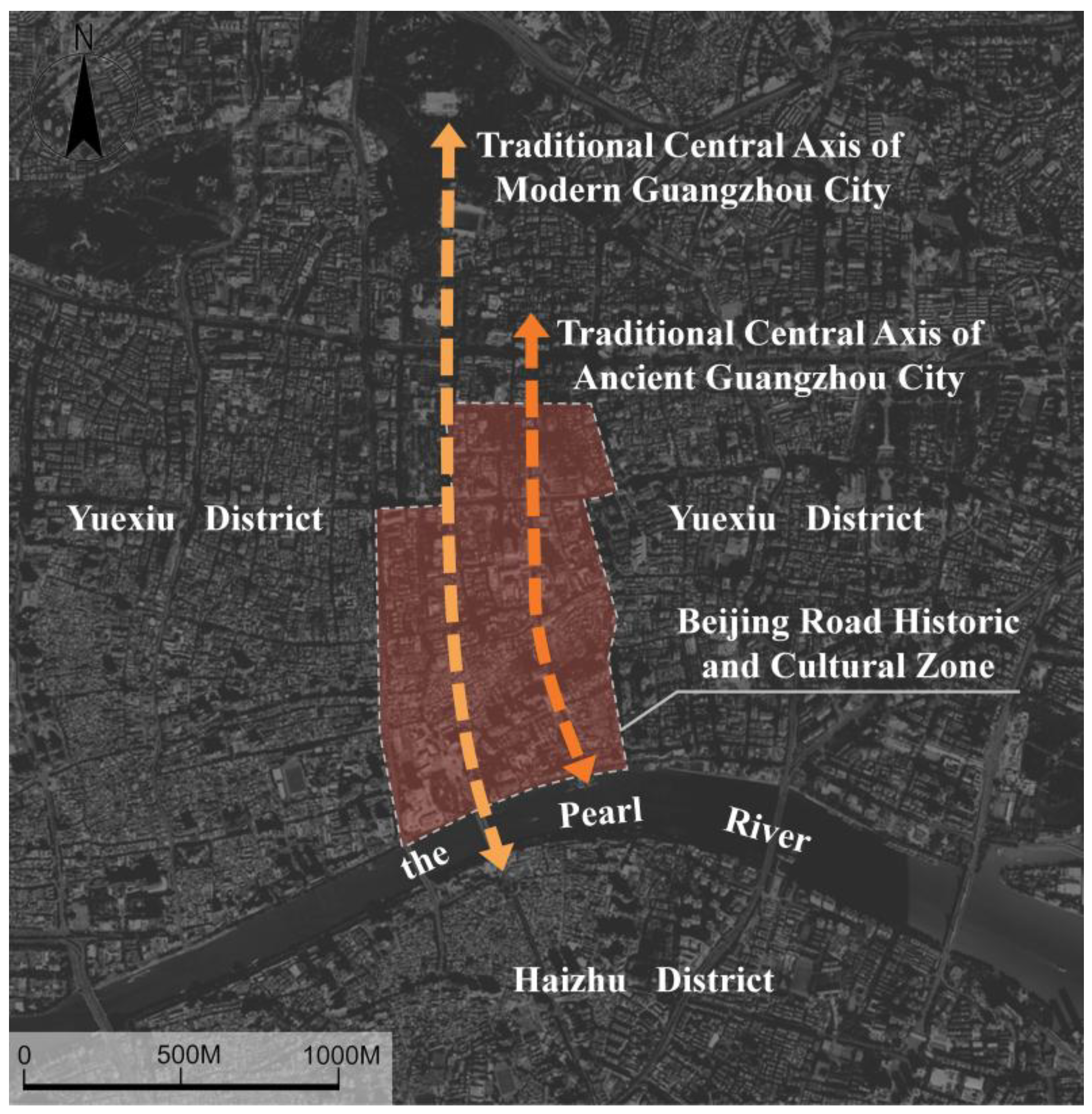
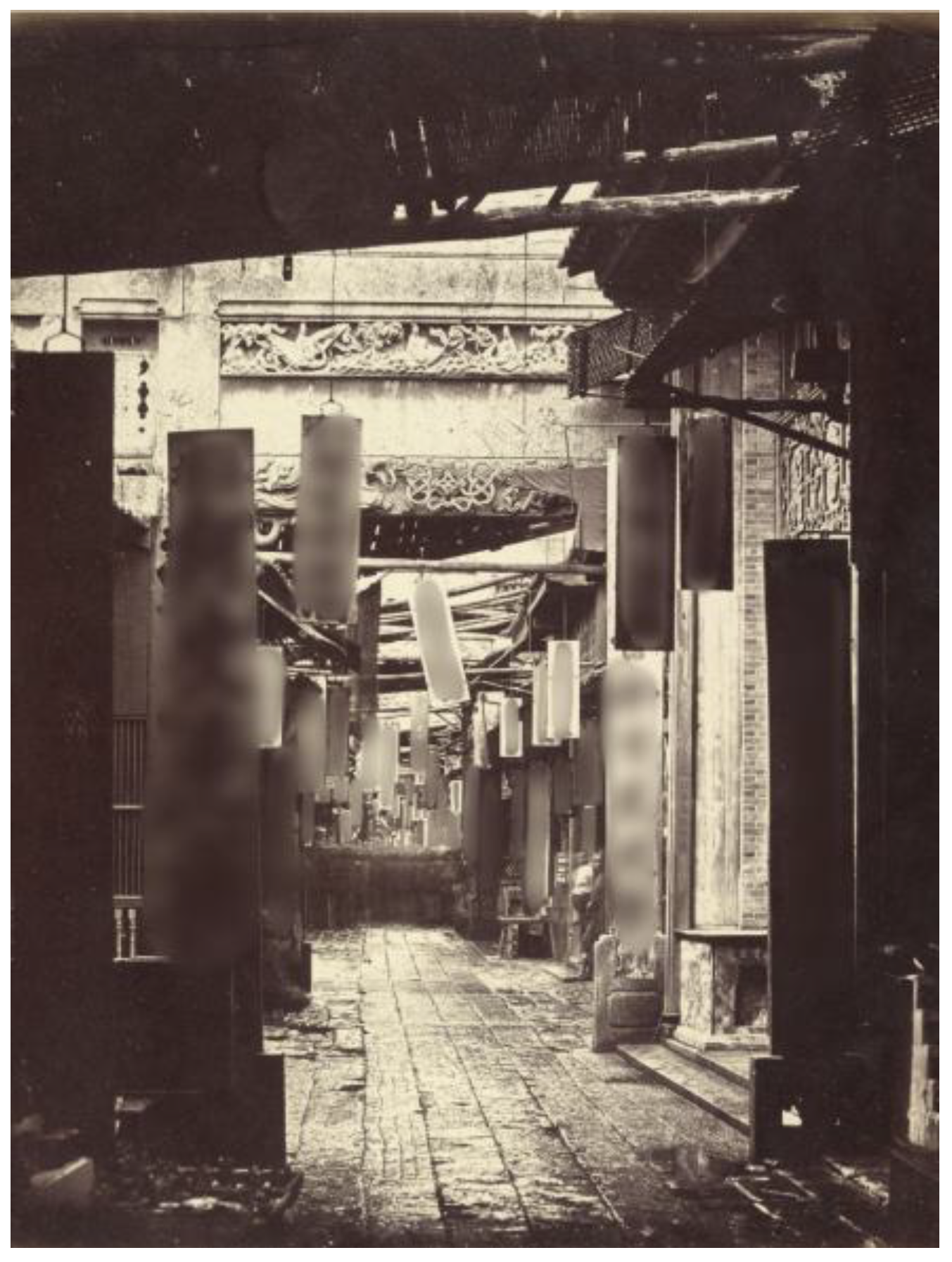
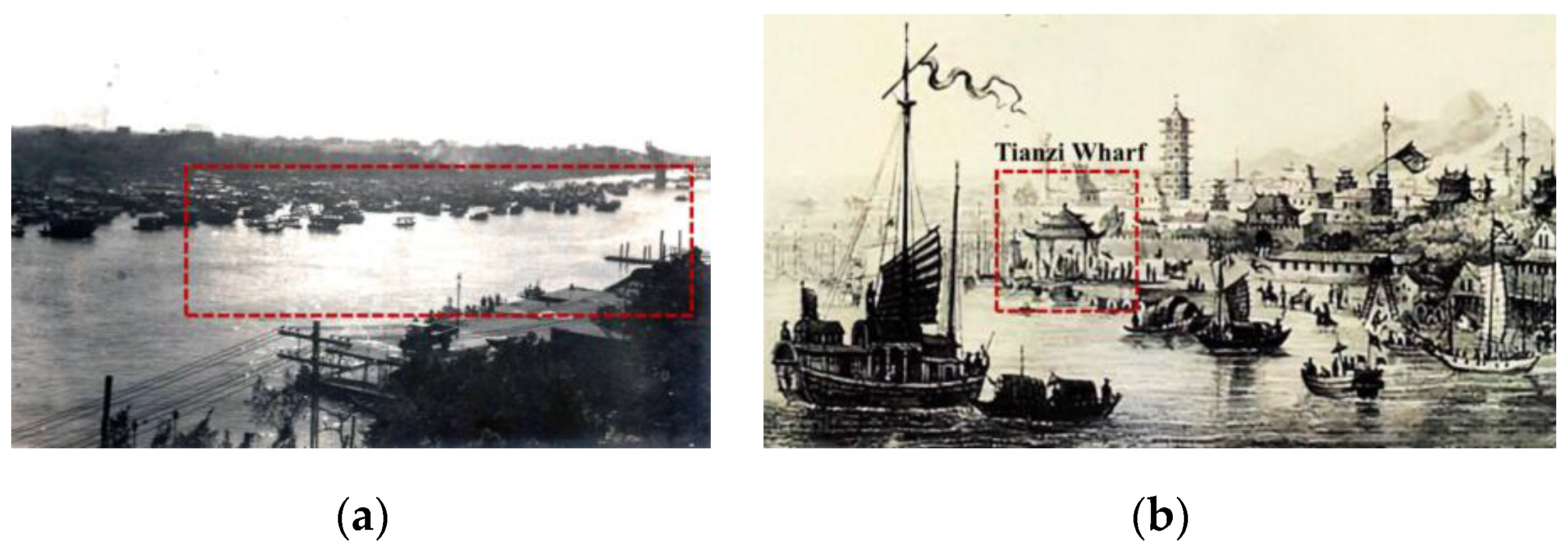
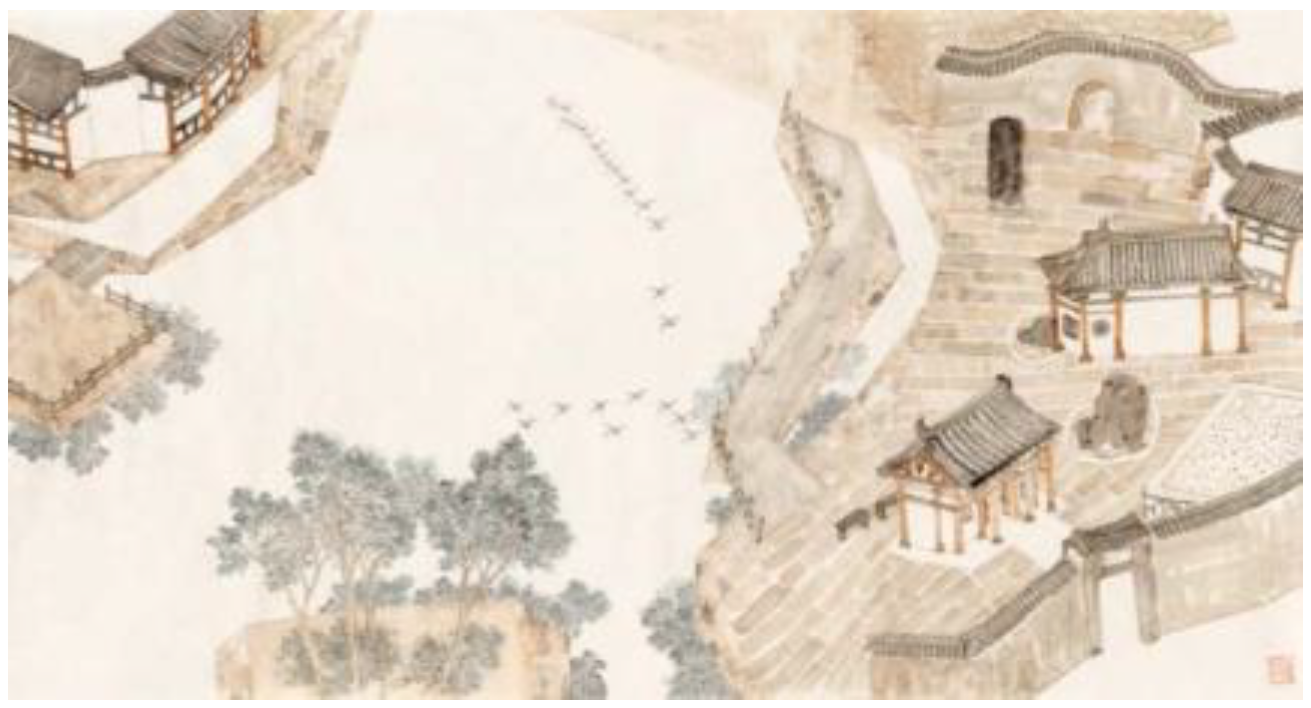
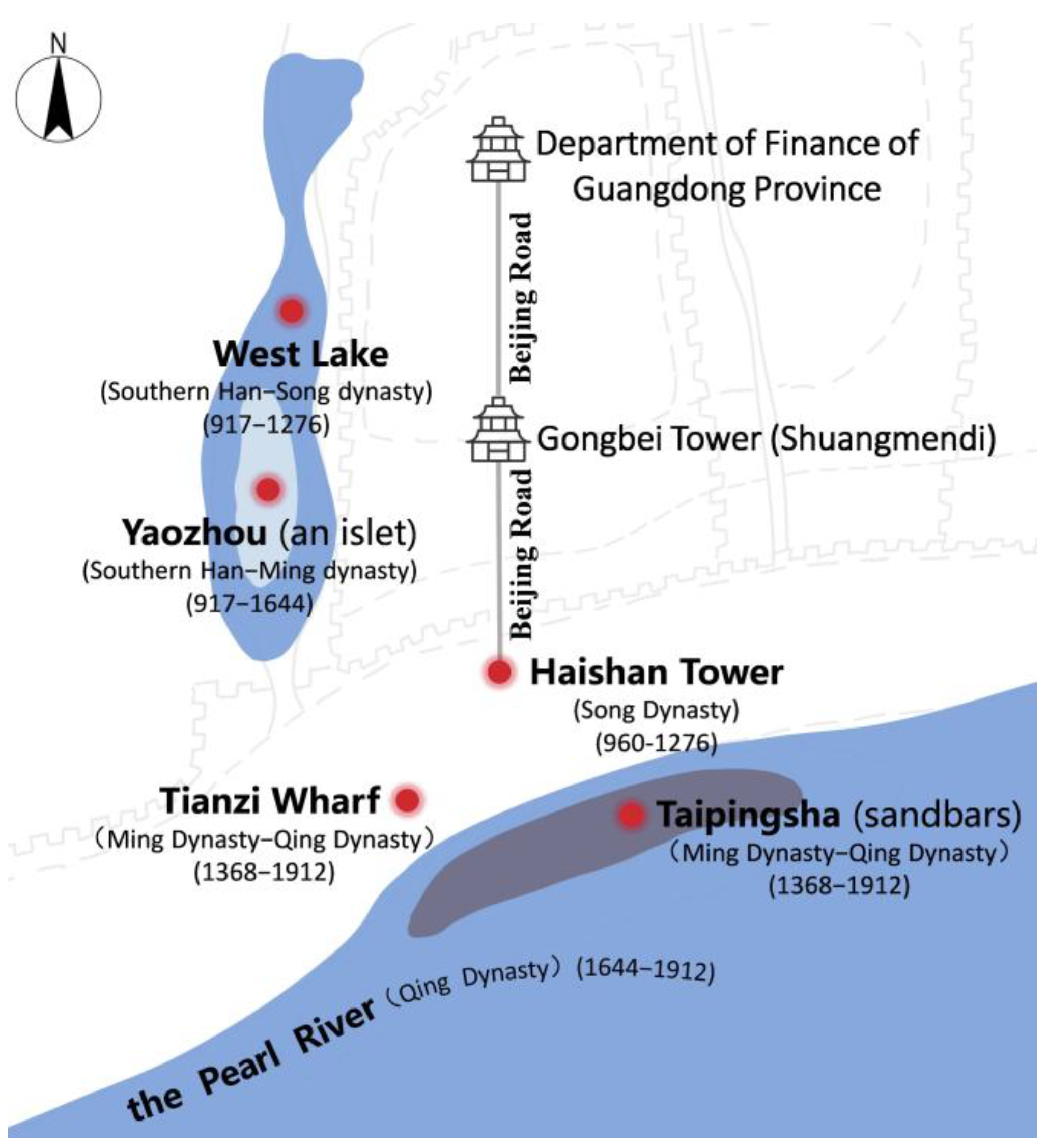
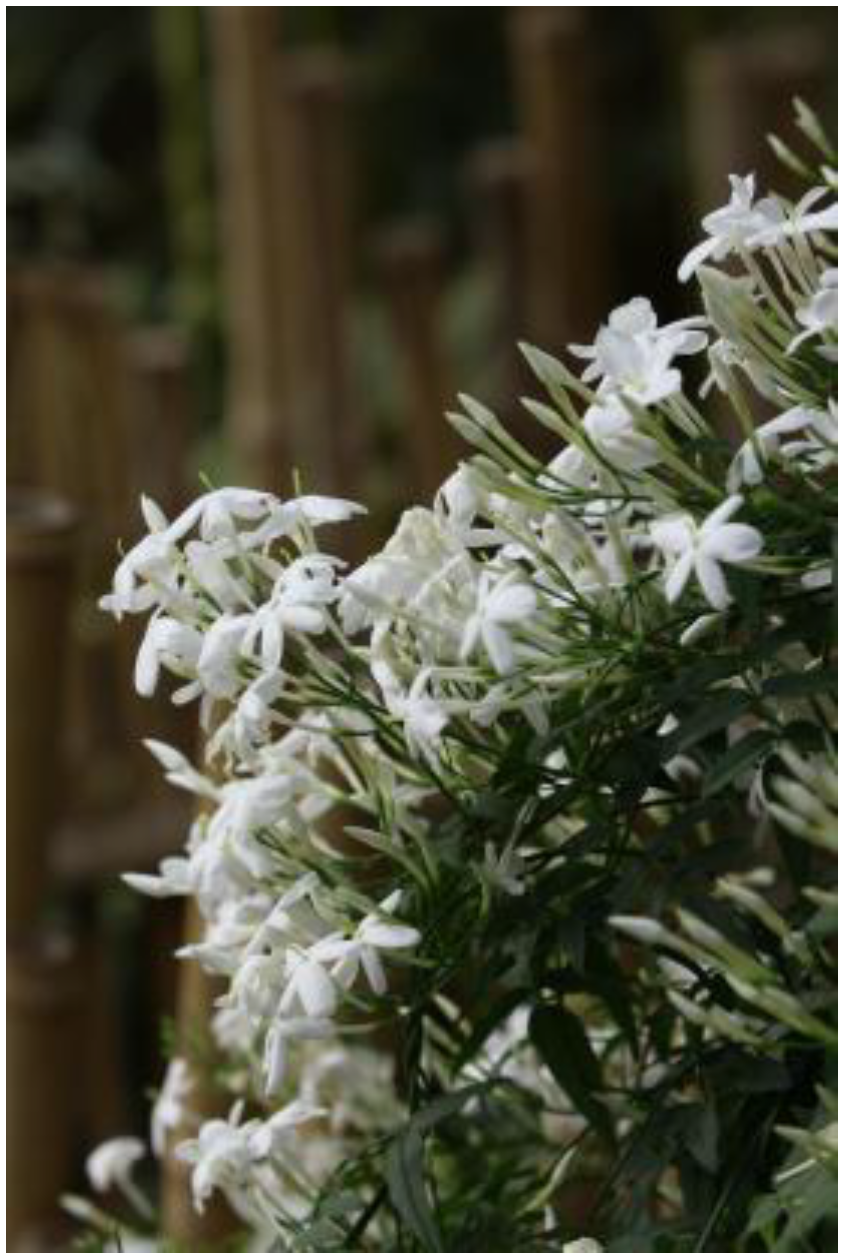
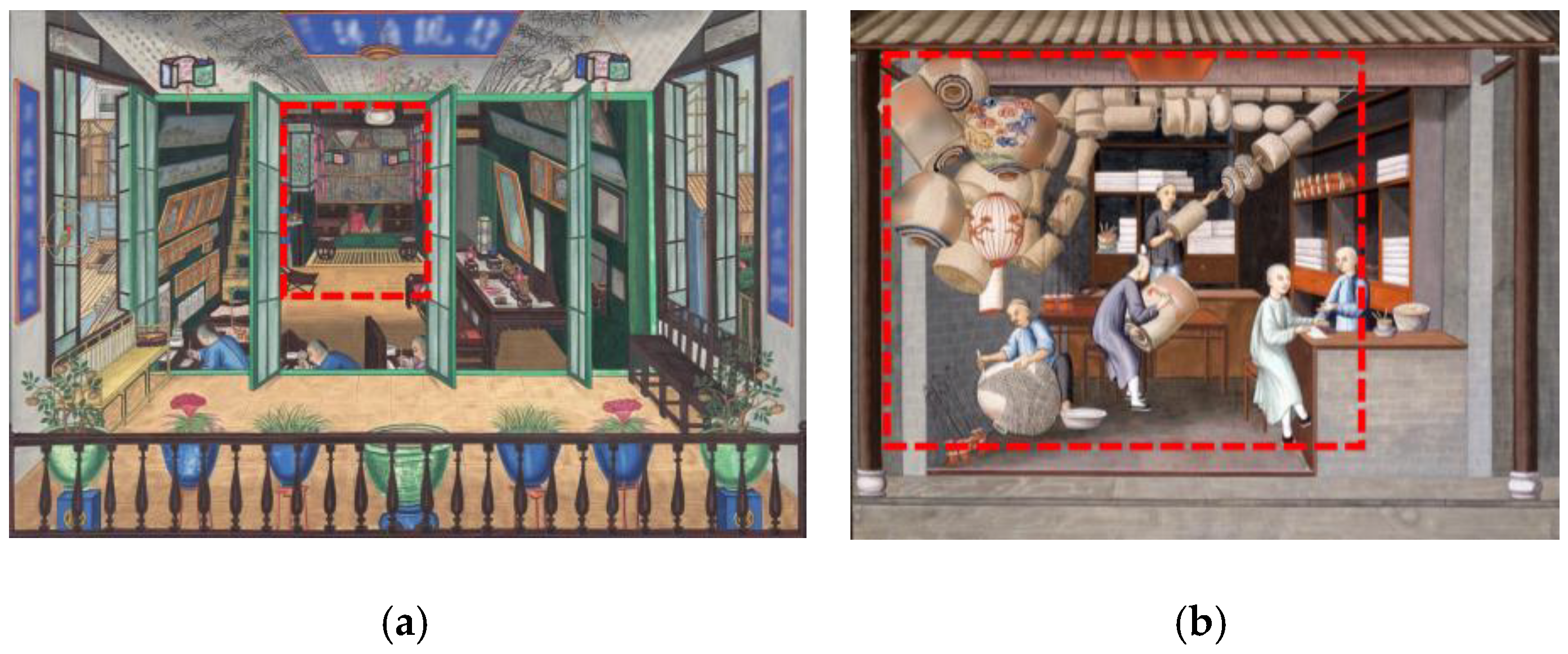
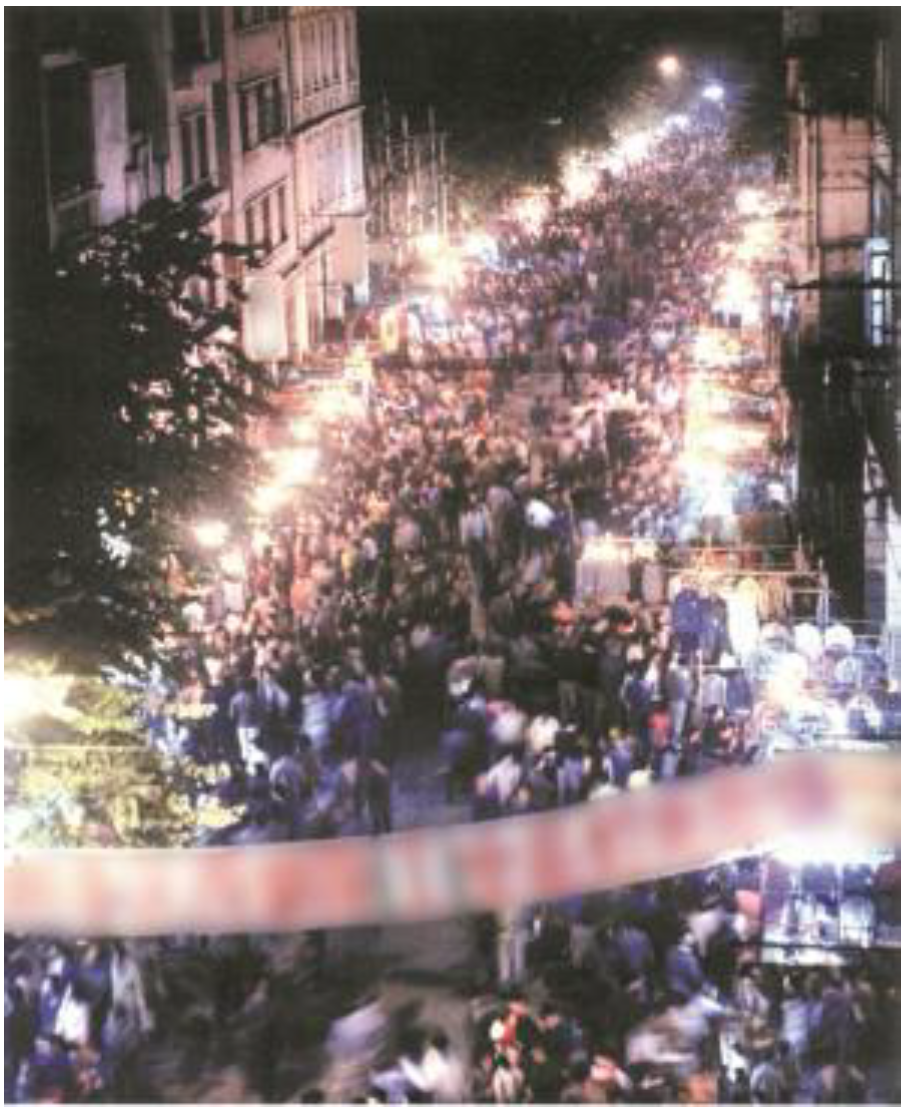
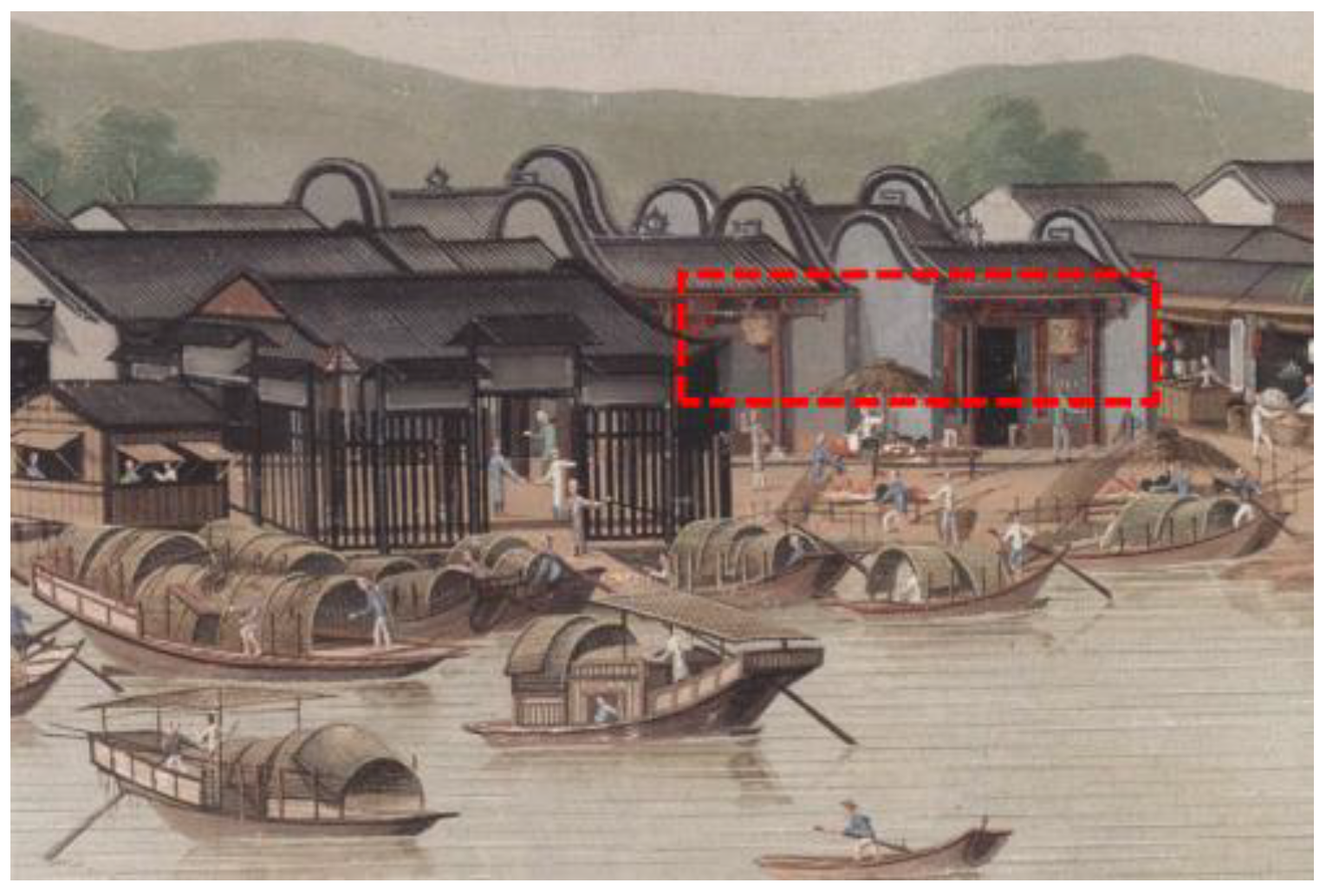
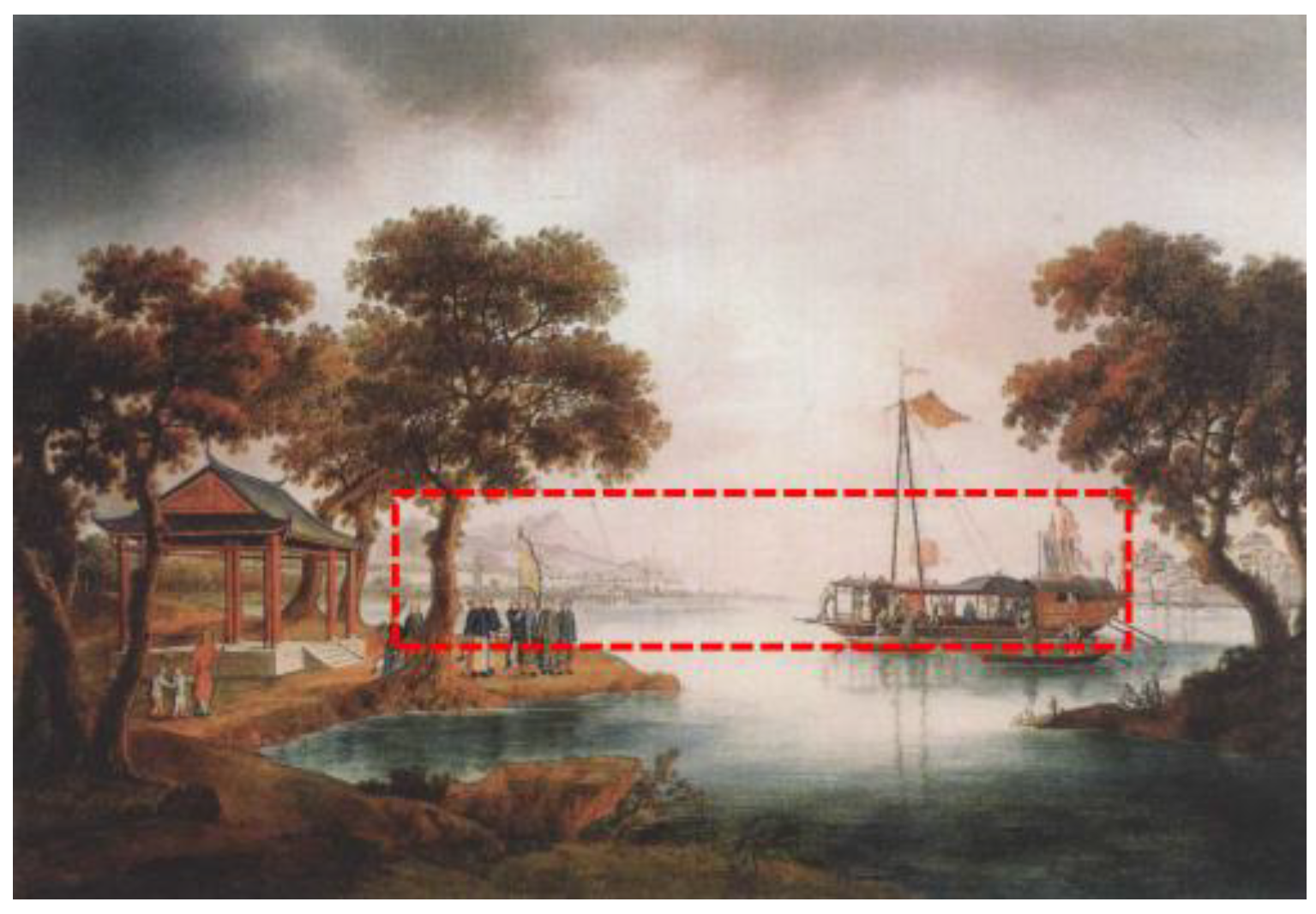

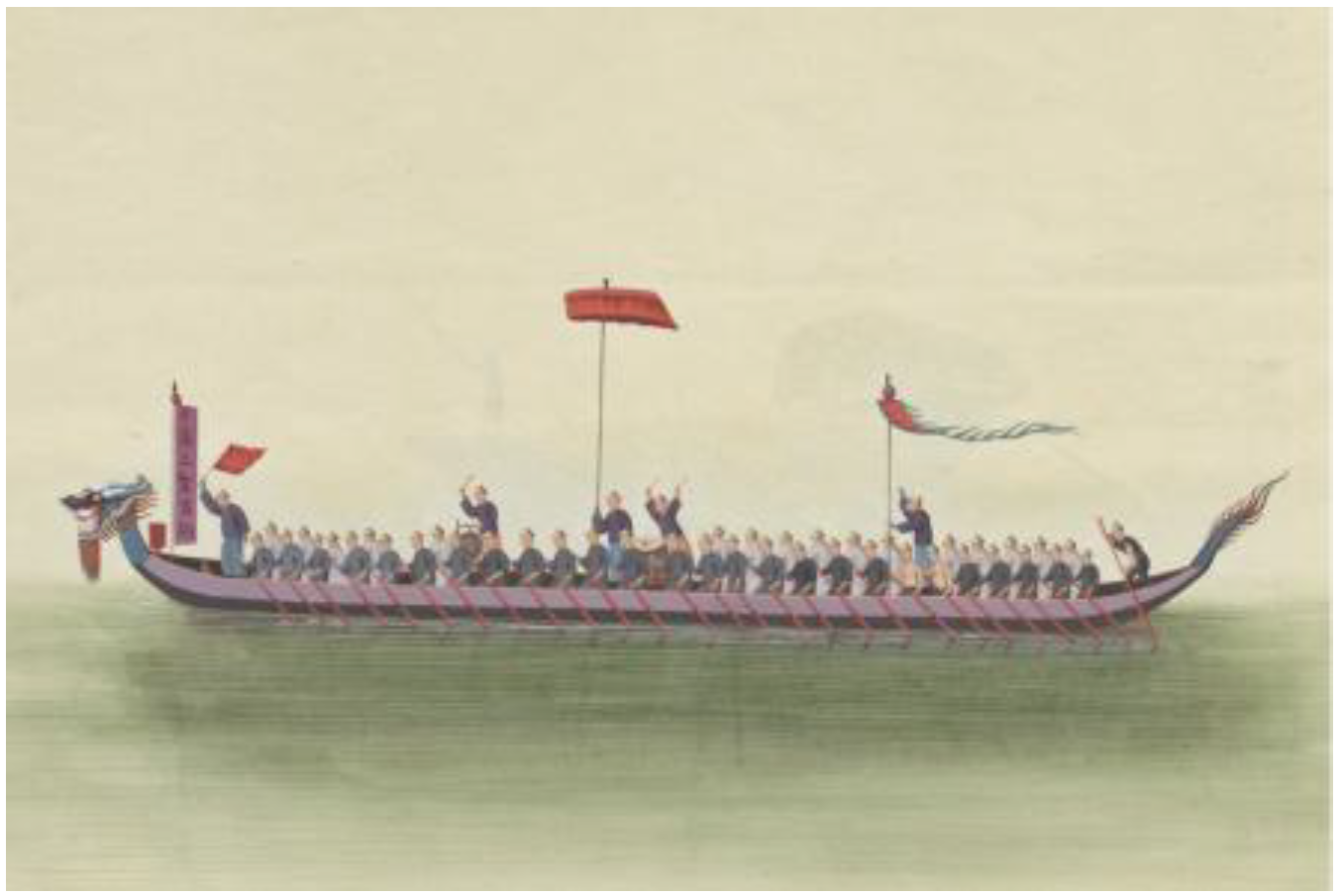

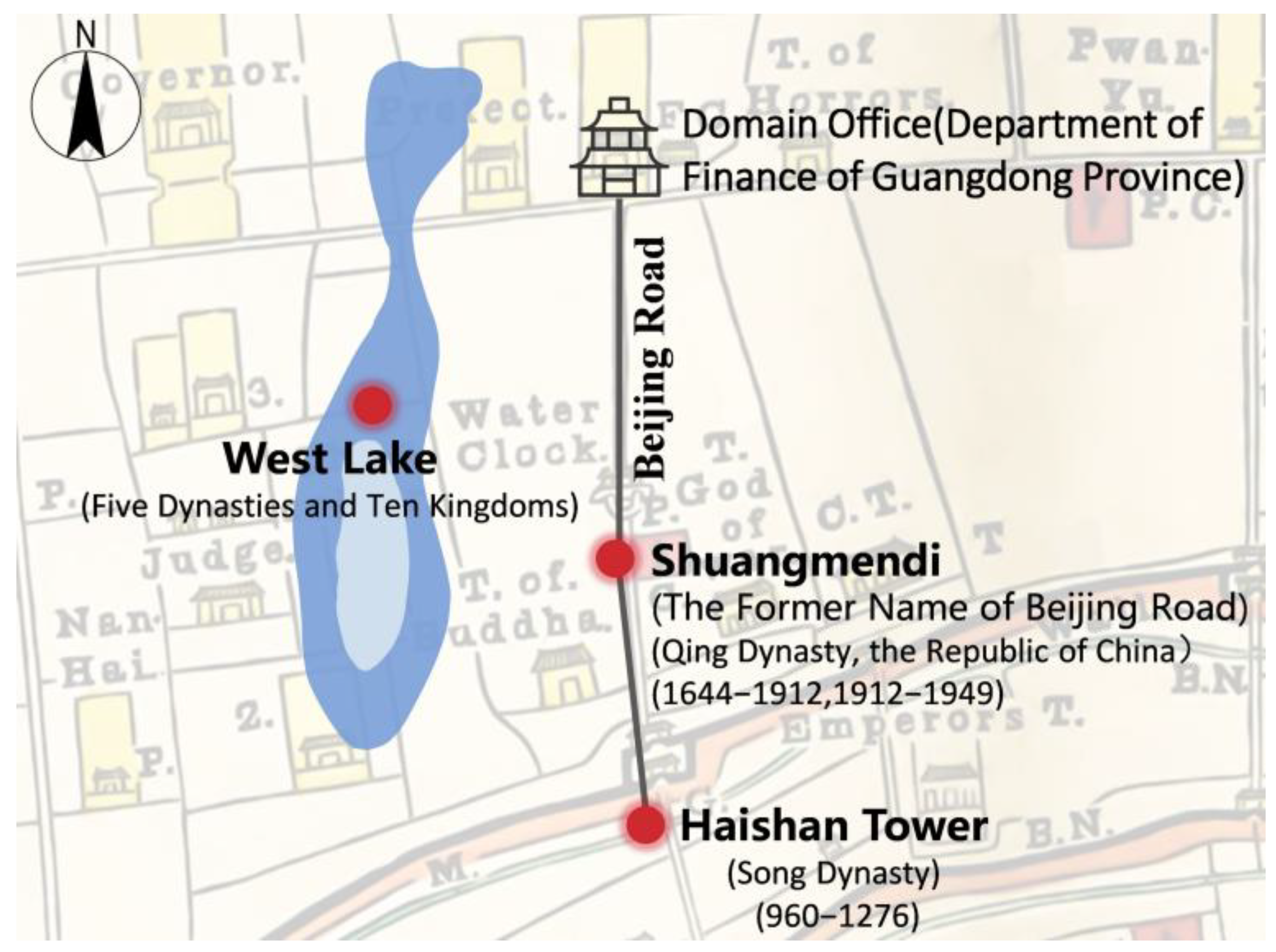
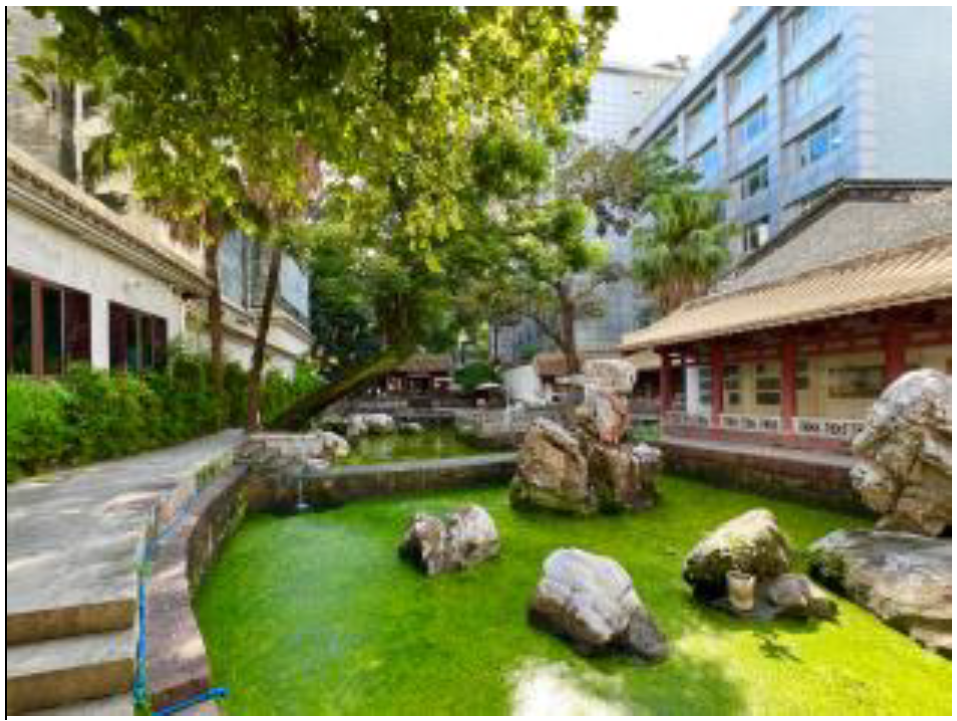
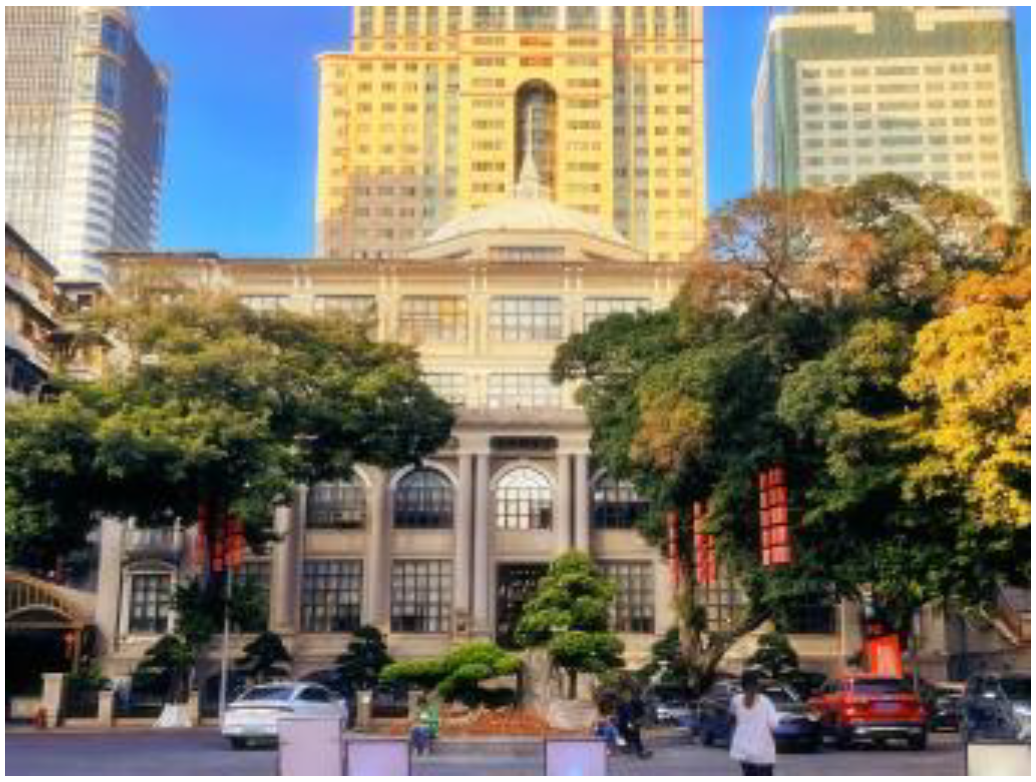
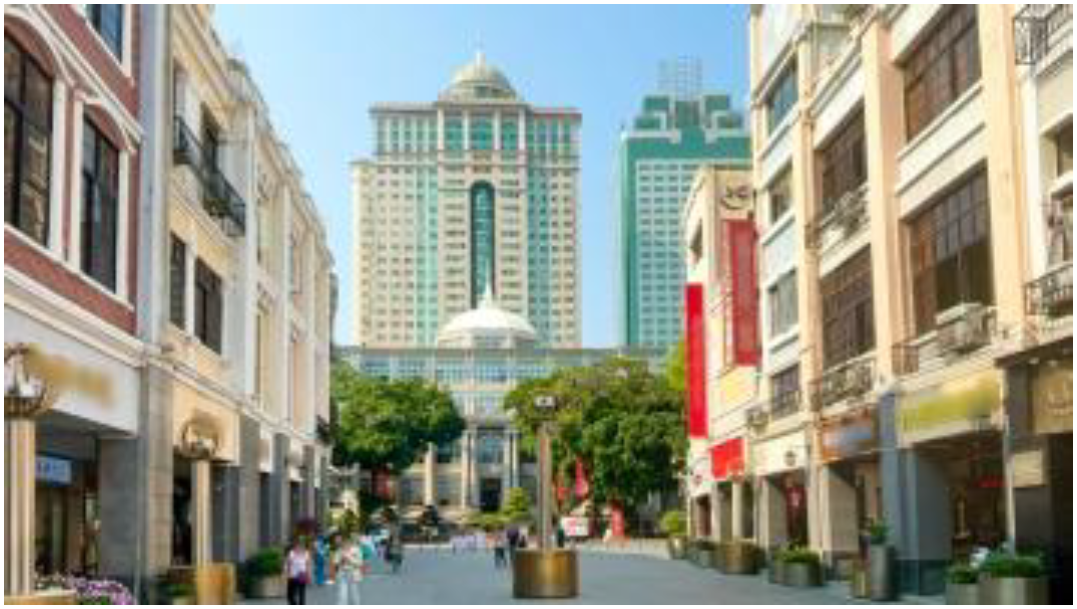
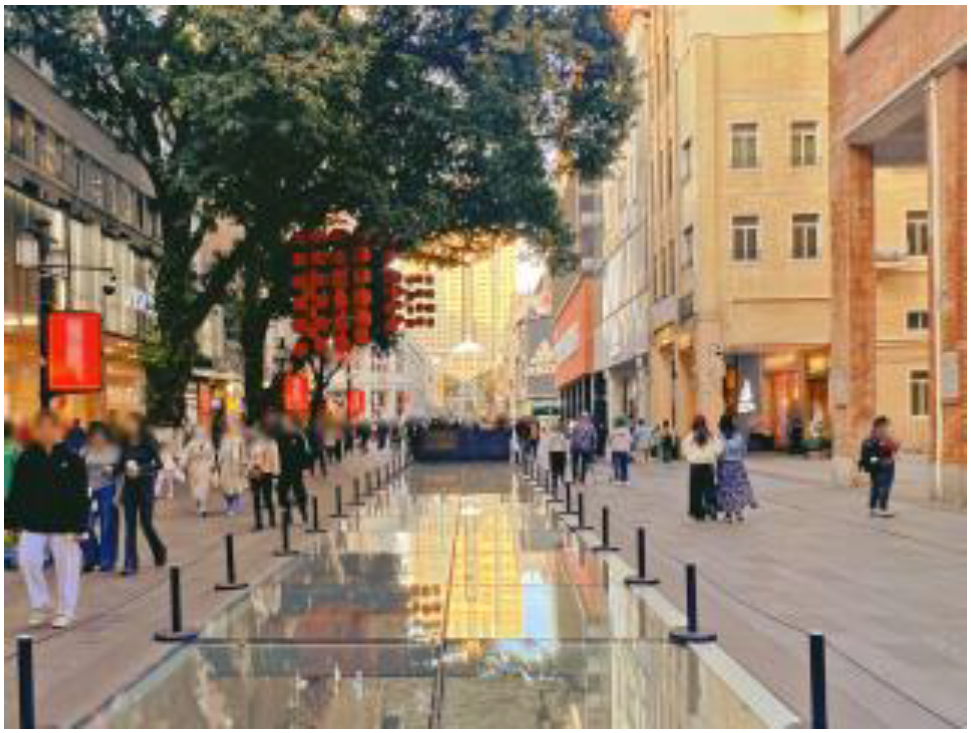
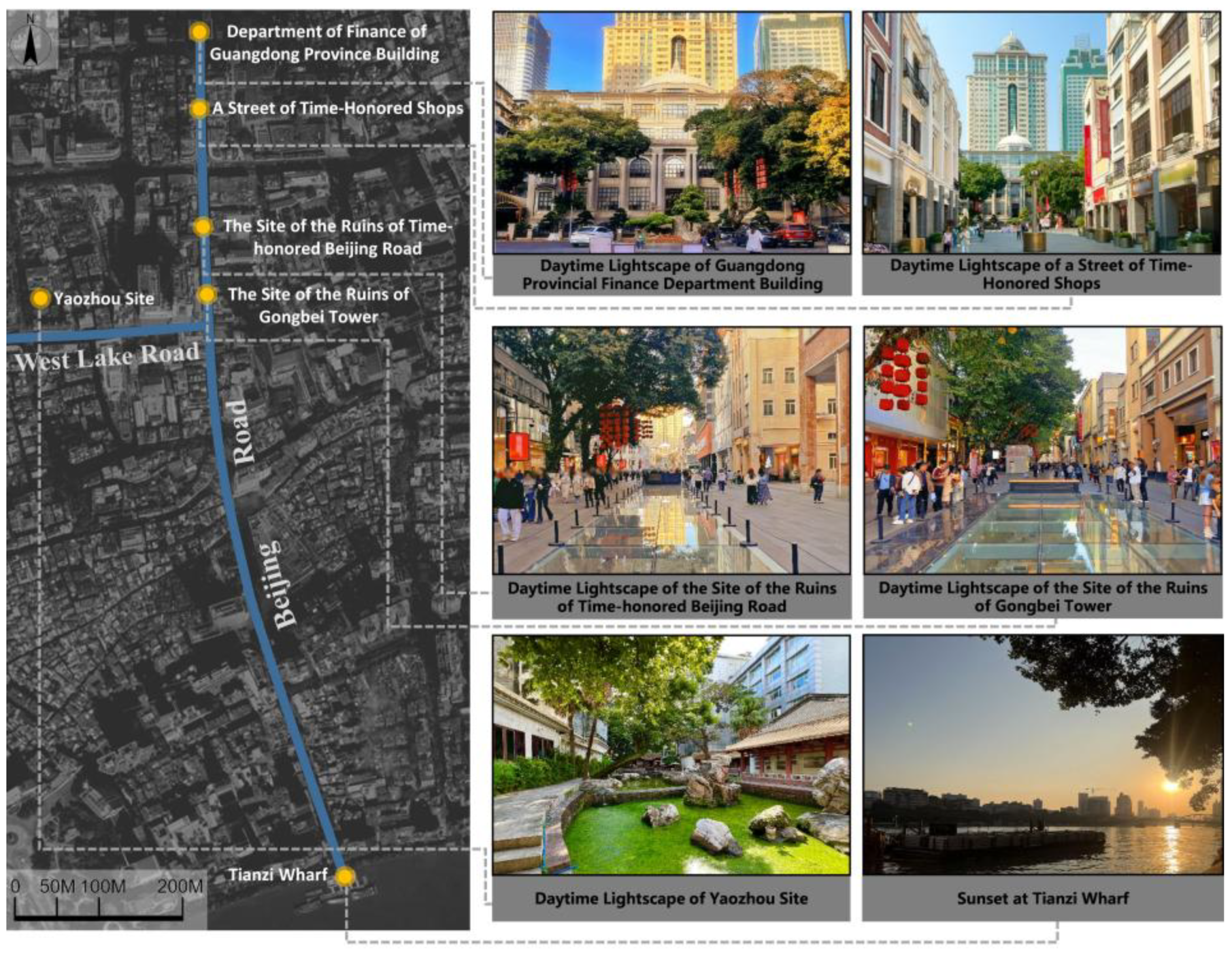

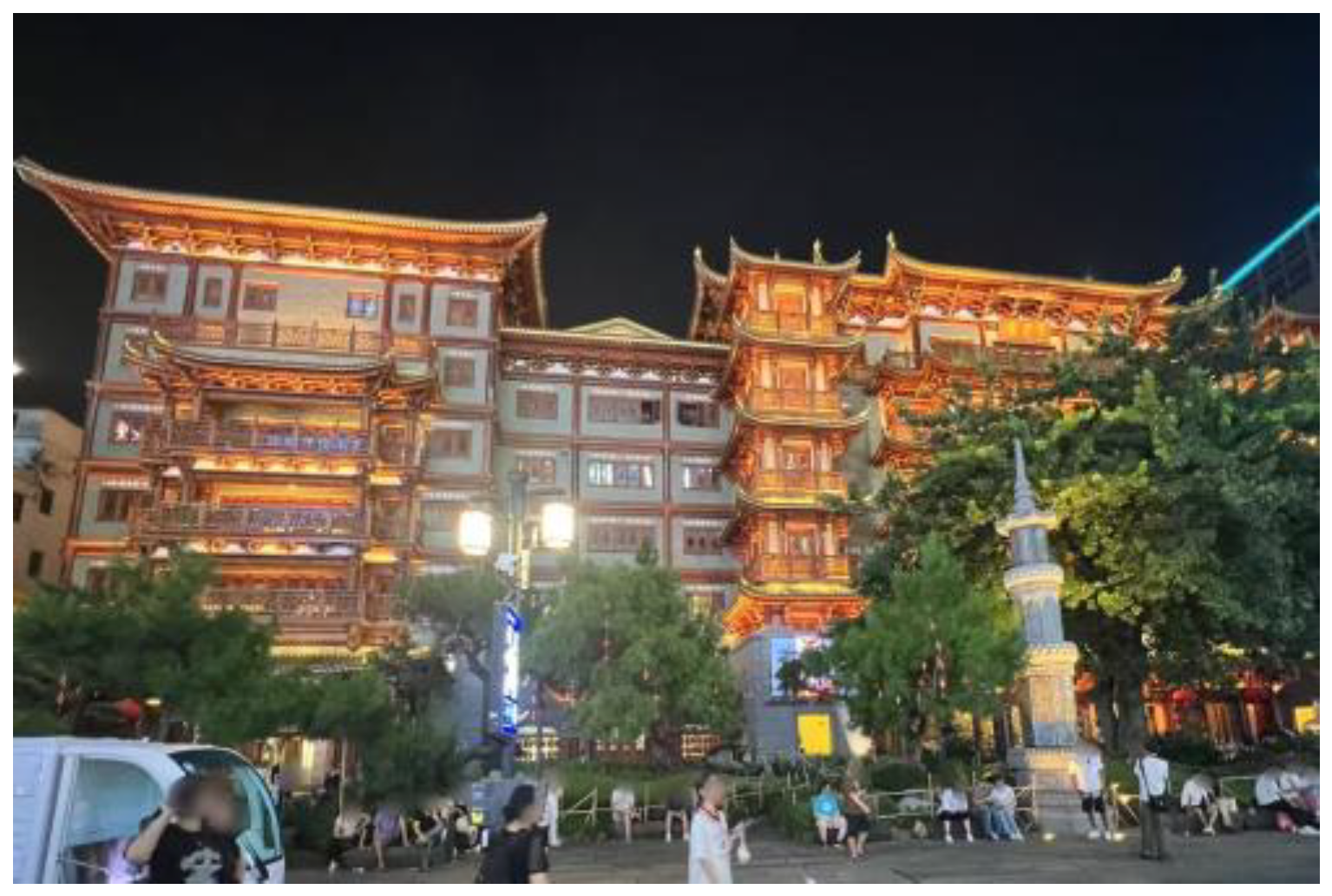
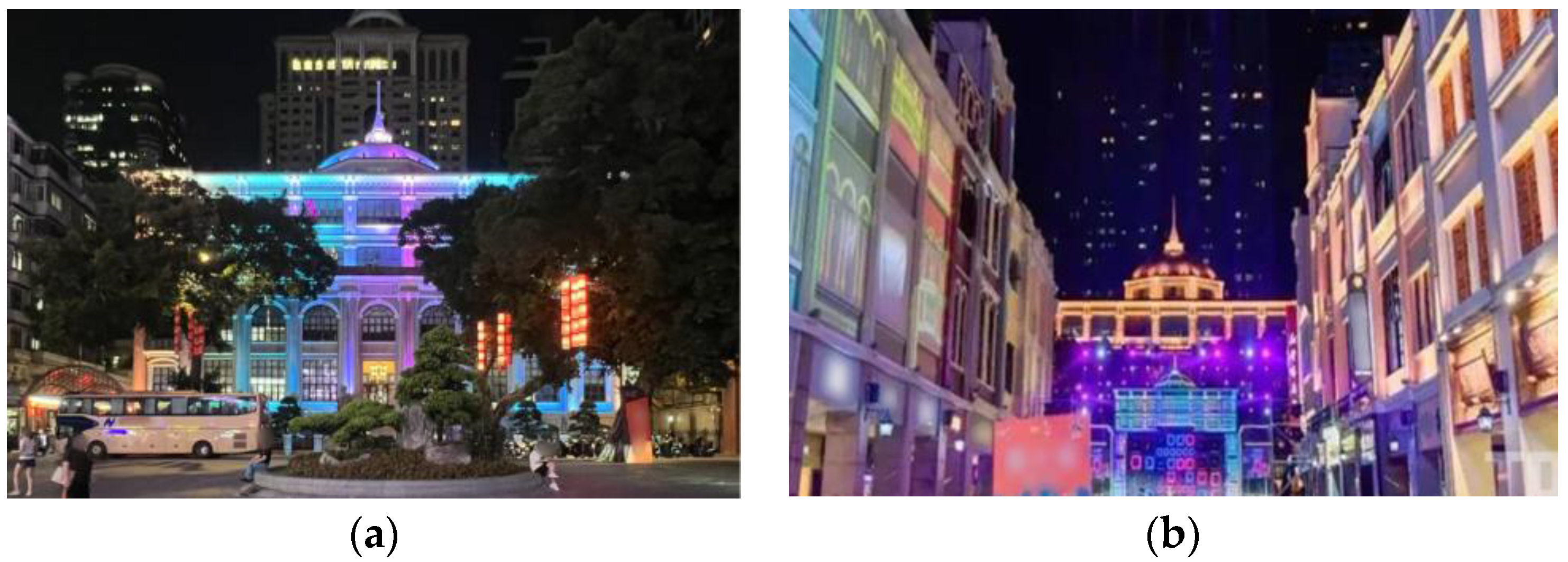

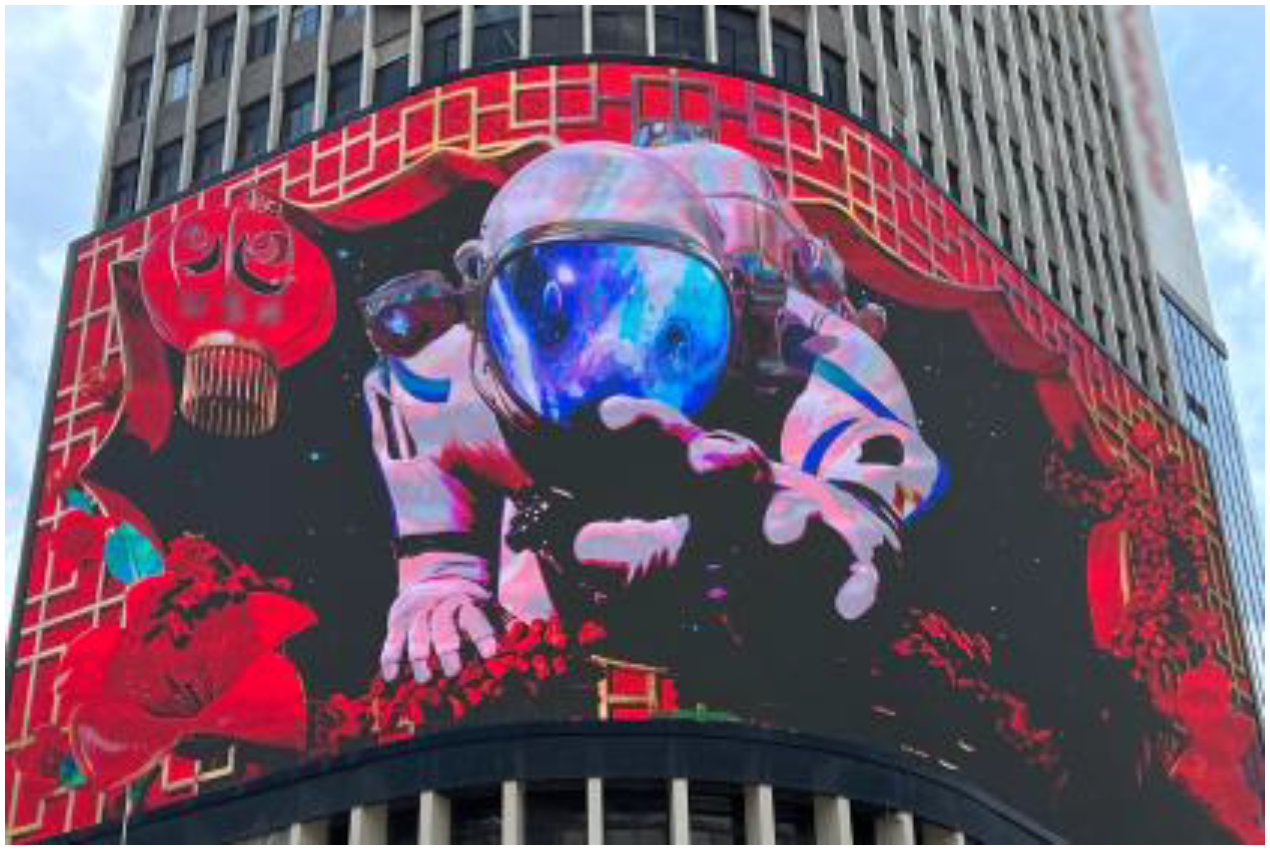
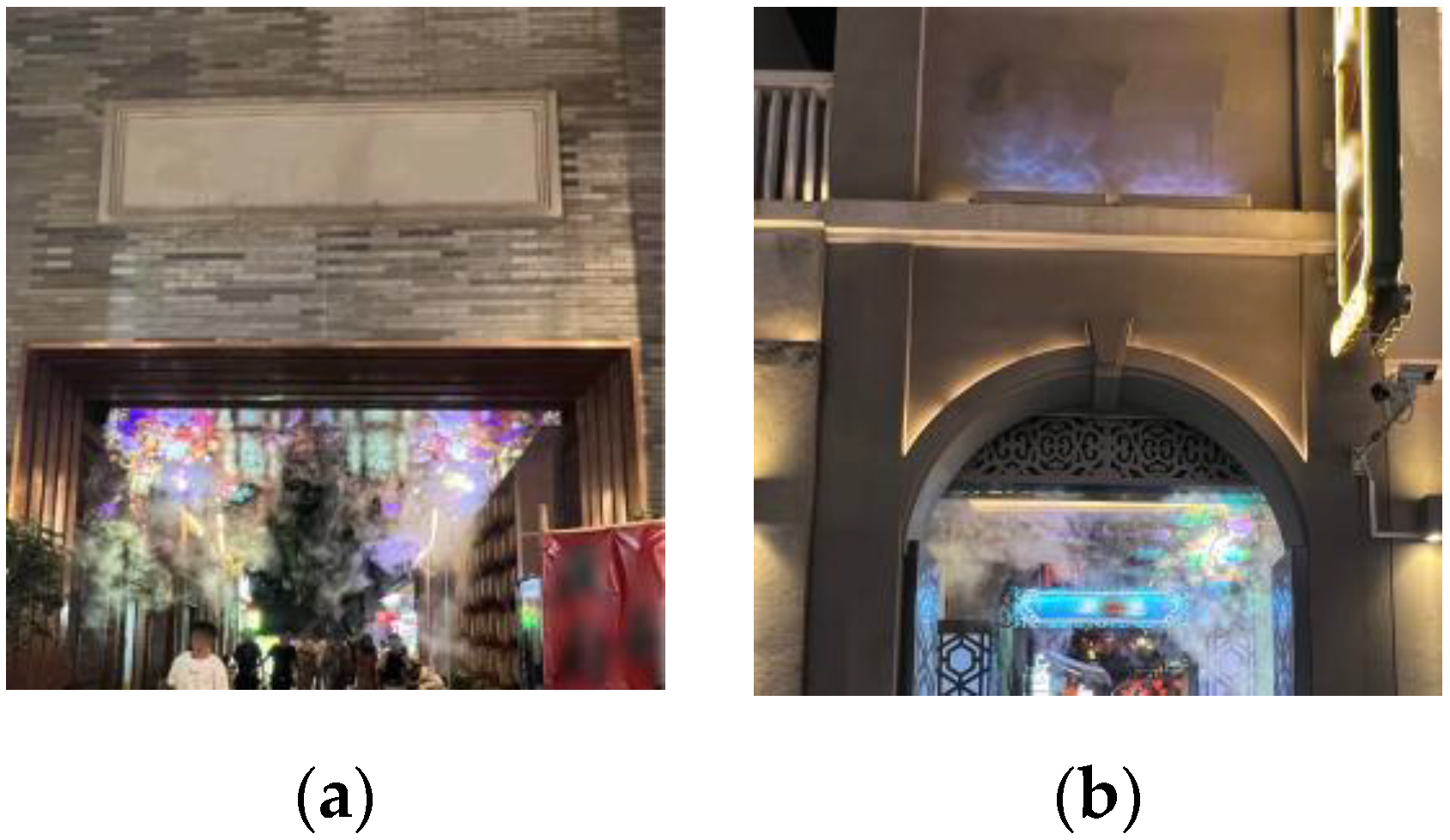

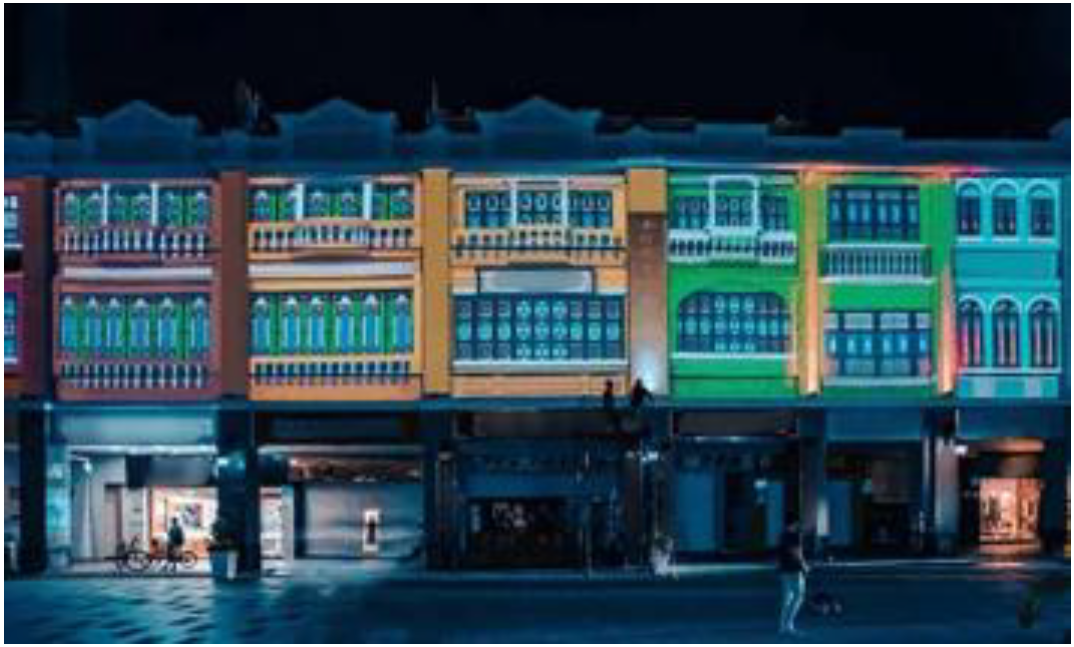

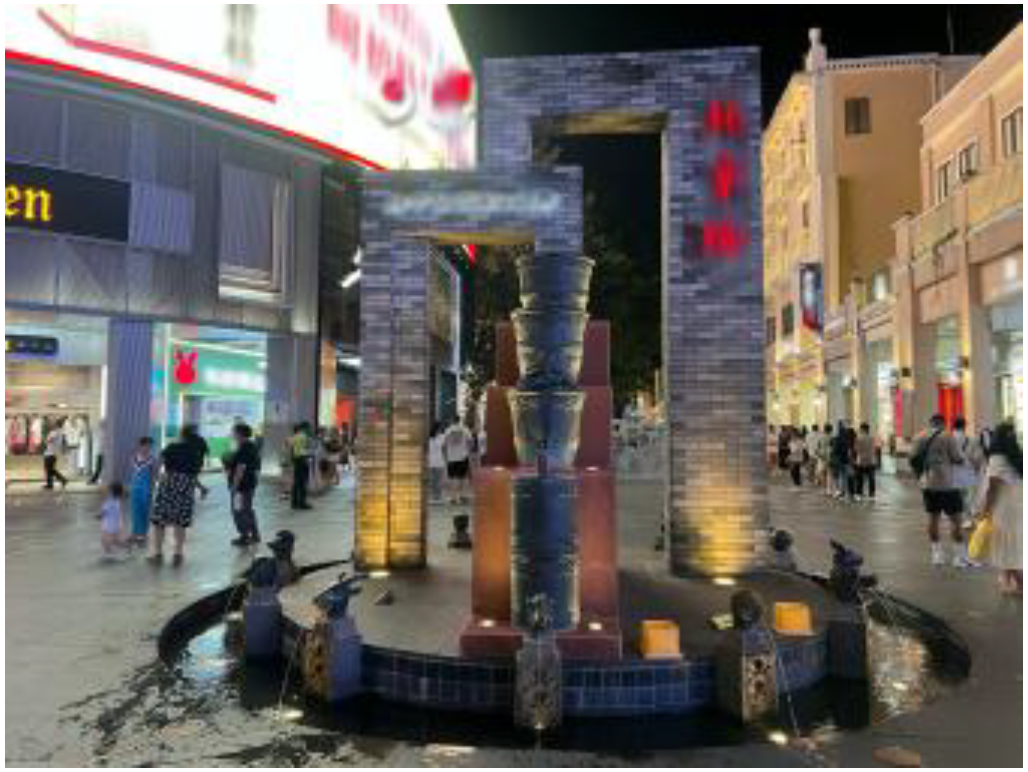

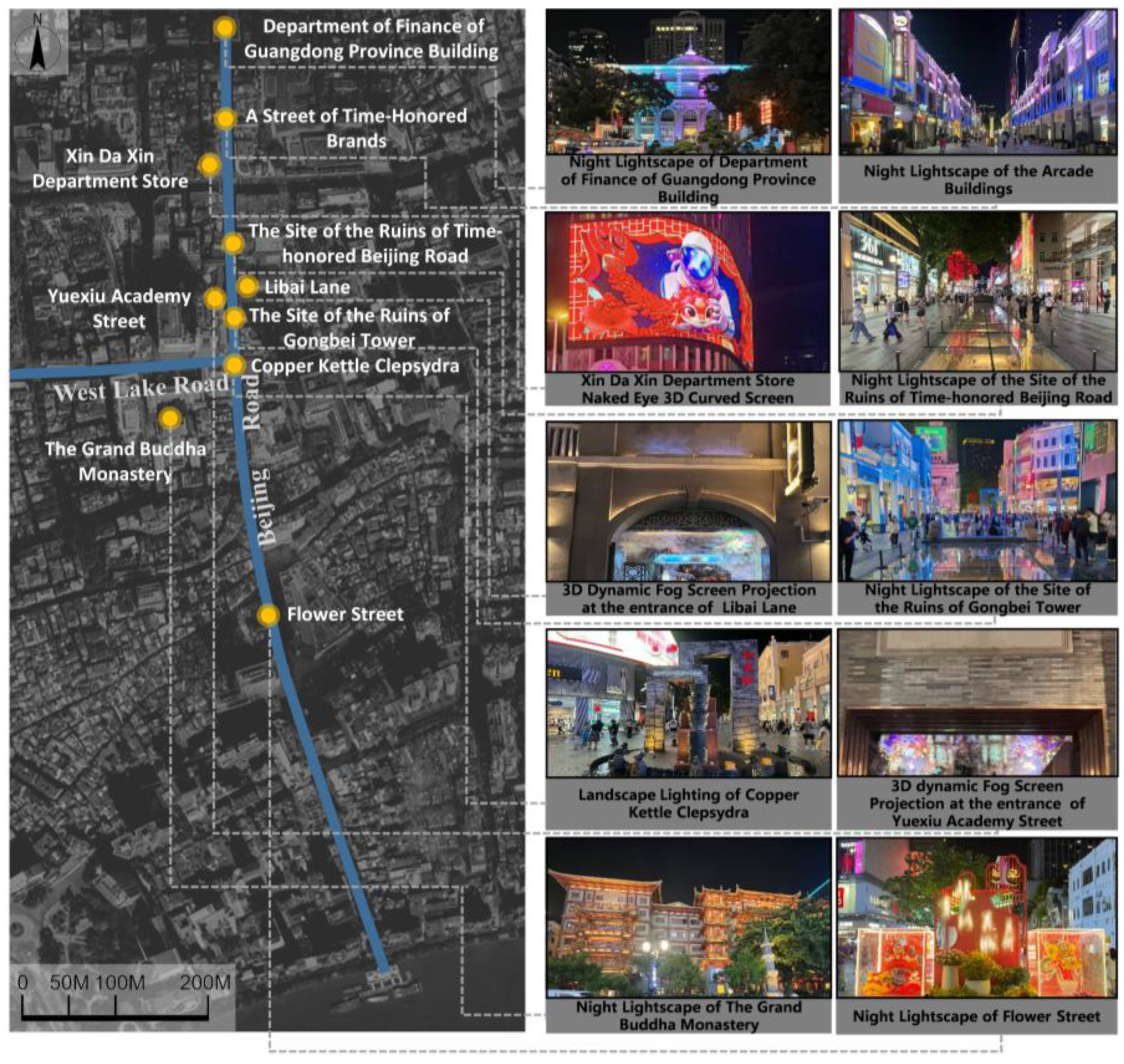
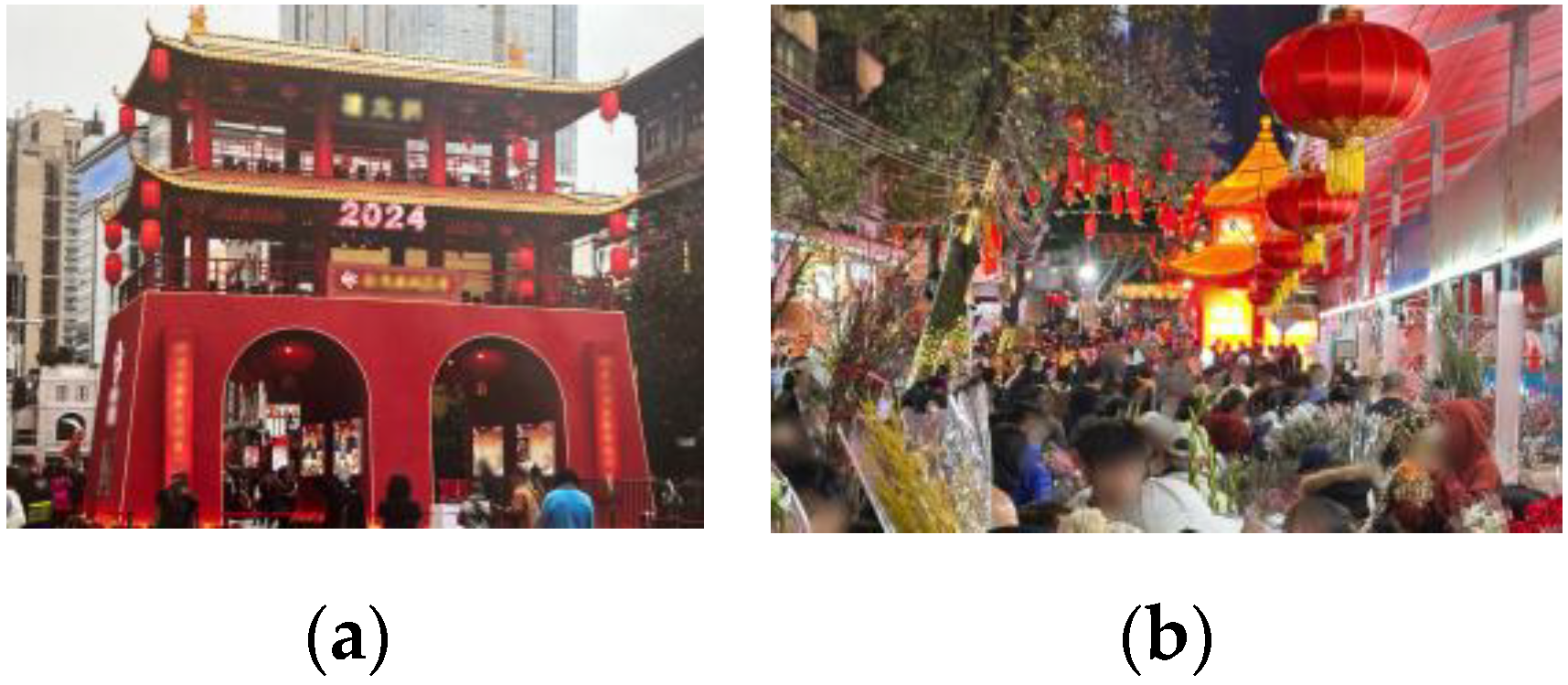
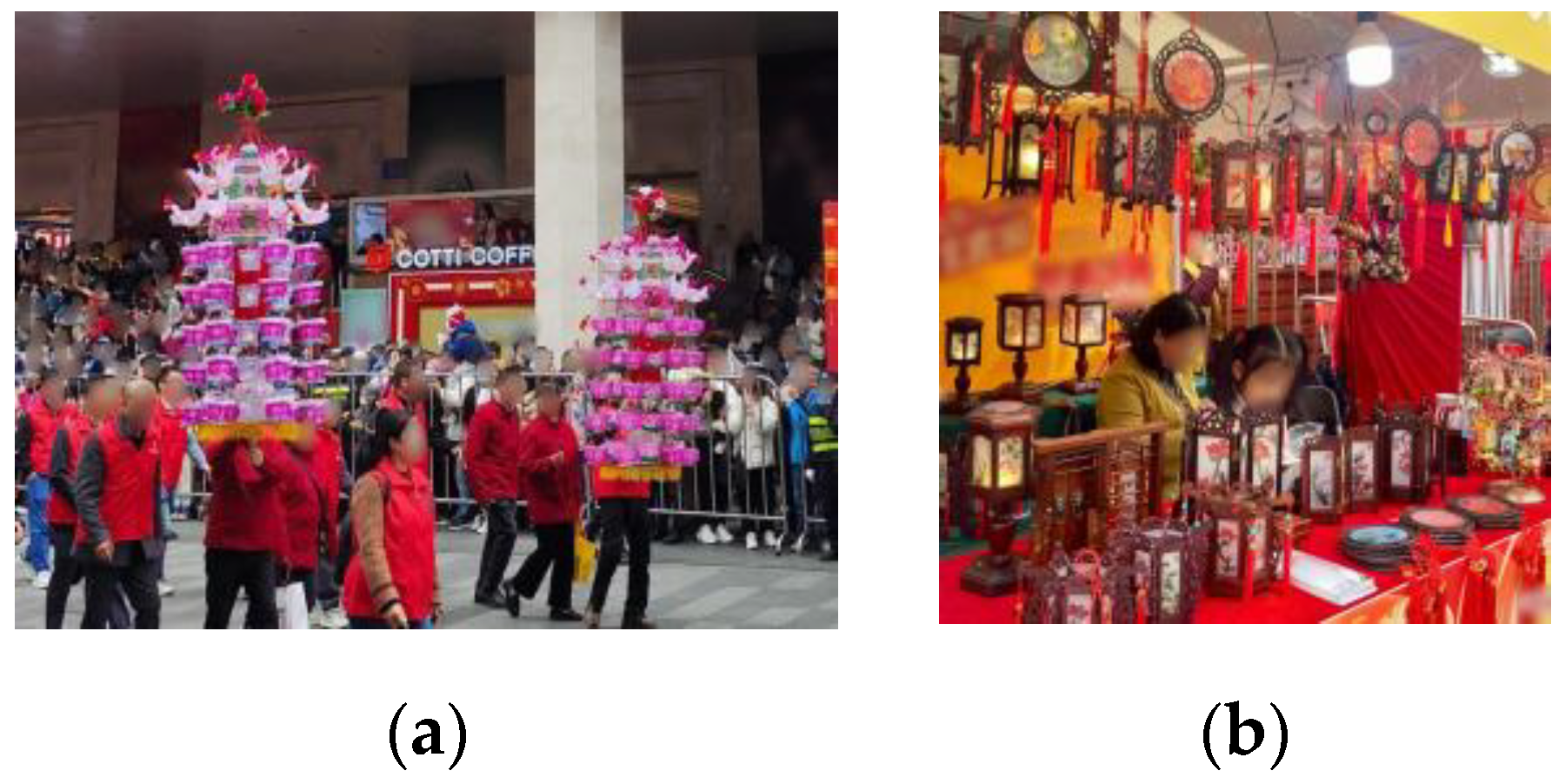
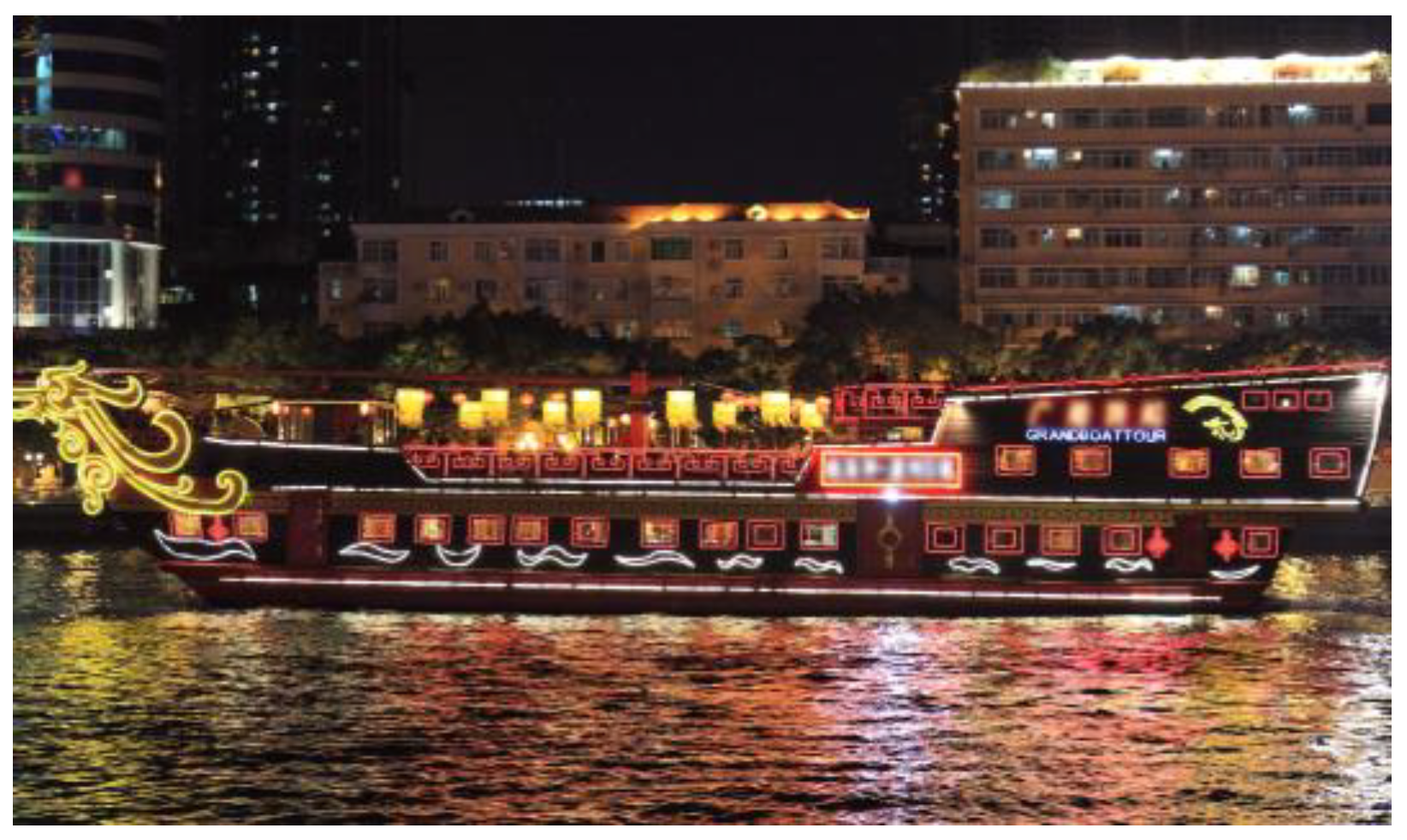
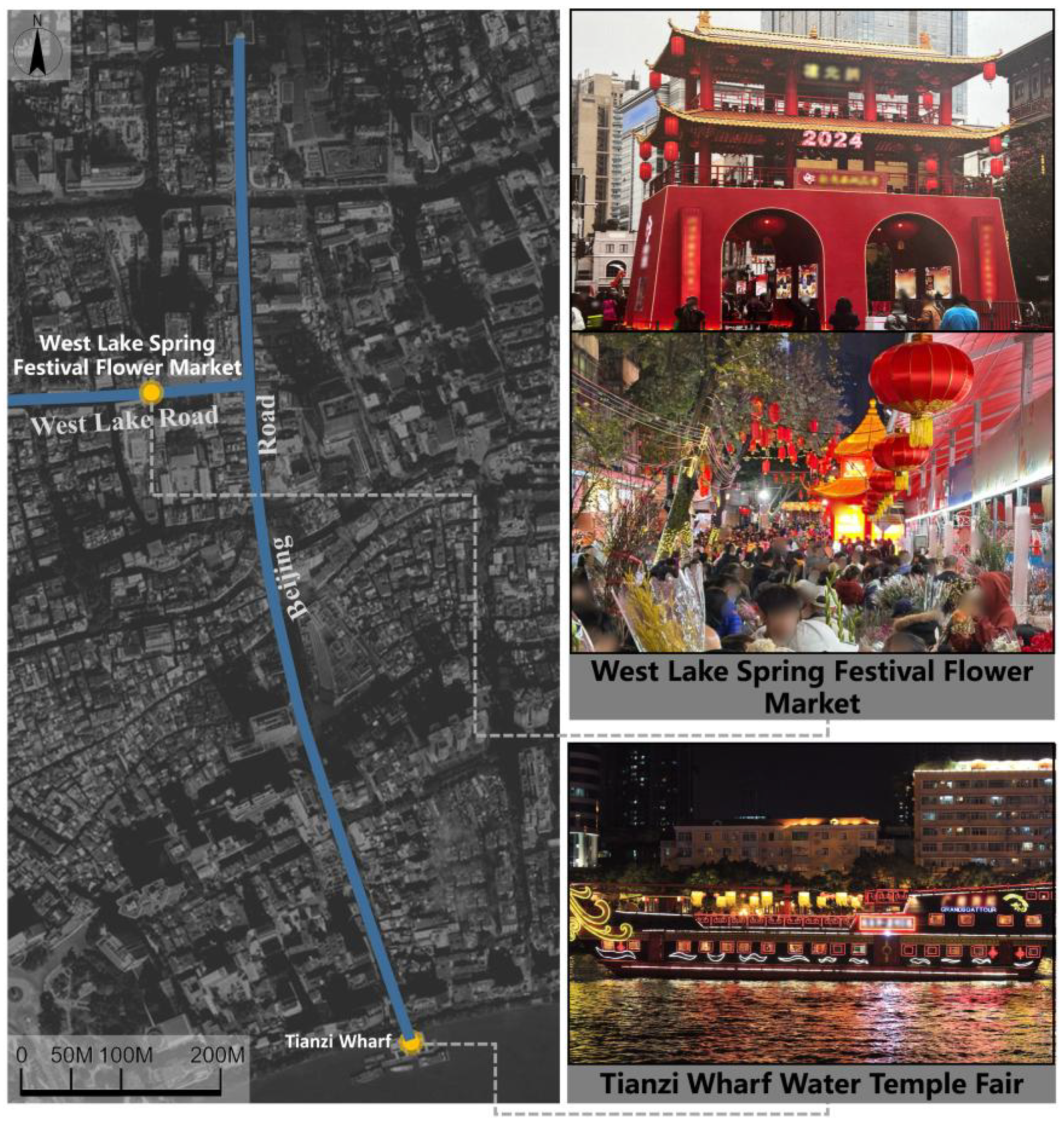

| Dynasty | Natural Lightscape | Location |
|---|---|---|
| Southern Han Dynasty (917–971) | The water and sky merged without distinction, floral fragrance and lotus shadow | West Lake, Yaozhou (an islet) |
| Song Dynasty (960–1276) | “Mirage appears in the blue sea, and summer clouds rise in the blue sky” “The anthers suffuse the sea island, cloud shadows in the water flow with the current of sand” “The solitary smoke floated in the sunset” | West Lake, Yaozhou (an islet) |
| “Hai Shan Xiao Ji (morning clarity in Haishan Tower)” “Spring seas spread in misty haze” “The reflection of the sky on the shore came in with the tide” | Haishan Tower | |
| Ming Dynasty (1368–1644) | “The Spring Sunrise of Yaozhou” | Yaozhou (an islet) |
| The sparkling surface of the Pearl River | Tianzi Wharf | |
| Qing Dynasty (1644–1912) | Water vapor permeates the sandbars Liu Hall: “Pond waters illuminate the dawn-lit trees” Xiuhai Tower: “The tower in the painting gets the moon first” Lubo Tower has mirrors reflecting the river sail | Taiping Yanhu area (Sandbar) |
| Dynasty | Artificial Lightscape | Location |
|---|---|---|
| From Ming Dynasty to Qing Dynasty (1368–1912) | Jasmine lantern: “Flowers are also suitable for making lamps, carving jade and ice, exquisite and radiant in all directions” | South Gate |
| “Myriad households hang jasmine lanterns” | each and every family | |
| “On the night of Qixi Festival in Guangzhou, there are many jasmine flower boats” | the Pearl River | |
| “There is also a Shuangmendi night market, with lamps resembling those of Suzhou and Hangzhou throughout the night” | Shuangmendi (the former name of Beijing Road) | |
| The shop signs and lanterns are brightly colored and painted with vibrant text or patterns | Shuangmendi (the former name of Beijing Road), the Grand Buddha Monastery | |
| Lantern in front of the “frying pan handle” house, lightscape of official activities at Tianzi Wharf | Tianzi Wharf, Rijin Pavilion | |
| “The shadow of moon pursues the shadow of lamps, the sound of books prevails over sounds of commerce” | Lujiang Academy | |
| After the reform and opening up (after 1978) | The West Lake Road illuminated night market | West Lake Road |
| Dynasty | Folk Lightscape | Location |
|---|---|---|
| Five Dynasties and Ten Kingdoms (907–979) | Dragon Boat Festival: “Every Dragon Boat Festival, palace attendants were commanded to race upon it and the colored boats competed to win out of the palace boudoir” People joyfully play with the shimmering waters and sunlight | West Lake |
| Song Dynasty (960–1276) | Lantern Festival: another major festival where colorful lights flicker inside the lamp shed | Haishan Tower |
| Qing Dynasty (1644–1912) | Birthday of the Lord Huaguang: “The lamps were painted with colors, the lights were brilliant” Flower Market: “The lamps and moon illuminate together, flower fragrance floods the air” | Shuangmendi (former name of Beijing Road) |
| Dragon Boat Festival Dragon boat race: “The dragon boats surge through waves. A streak of setting sun illumines splendor bright” | the Pearl River | |
| Republic of China (1912–1949) | Lantern Festival: riddle arenas combined with exquisitely crafted lanterns | Shuangmendi (former name of Beijing Road) |
| Lightscape Type | Space Type | Function of the Location | Lightscape Elements | Environmental Landscape Elements | Natural Lightscape Distribution Map | Picture |
|---|---|---|---|---|---|---|
| Lightscape of the Pearl River near Tianzi Wharf | Waterfront space | Viewing | Wave light, reflection | Waterscape |  | 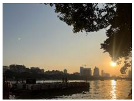 |
| Lightscape of West Lake and Yaozhou site | Waterfront space | Viewing | Lake light, tree shadow, lake reflection | Stone scenery, pavilions, stone bridges and waterside pavilions | 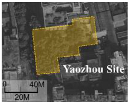 | 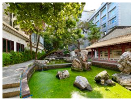 |
| Light and shadow of arcade buildings | Street space | Traffic, leisure | Tree shadow, architectural light and shadow | Green plants, landscape sketch | 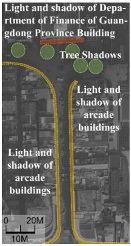 | 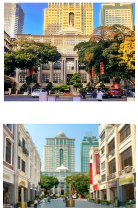 |
| Lightscape of the site of the ruins of time-honored Beijing Road and Gongbei Tower | Street space (pedestrian area | Viewing, leisure | Tree shadow, glass reflection, light and shadow of surrounding arcades | Old trees, landscape sketch | 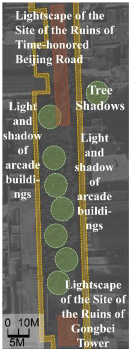 | 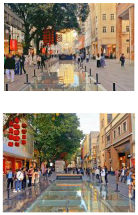 |
| Lightscape Type | Space Type | Function of the Location | Lightscape Elements | Environmental Landscape Elements | Artificial Lightscape Distribution Map | Picture | |
|---|---|---|---|---|---|---|---|
| Lamps and lanterns | Arcade ground floor colonnade, pedestrian street | Traffic, leisure | Street lamps, lanterns, lamp strips, billboard lights | Green plants, stalls, sculptures | 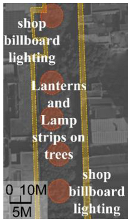 |  | |
| Building lighting | Lightscape of the Grand Buddha Monastery at night | Front square | Traffic, leisure and stay | Building facade lighting, Grandbuy facade media display, surrounding building lighting | Green plants, flower pools, pavilions, towers | 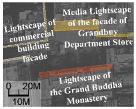 |  |
| Lightscape of Department of Finance of Guangdong Province Building at night | Front square | Traffic, leisure and stay | Building facade lighting, lanterns hanging from trees, and surrounding building lighting | Green plants, flower pool, landscape sketches | 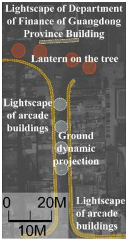 |  | |
| Lightscape of arcade facade at night | Pedestrian road | Traffic, leisure and stay, interaction | Holographic dynamic projection on the ground, building facade lighting, billboard lighting | Flower pool, landscape sketches |  | ||
| Lightscape of multimedia technology | Xin Da Xin Department Store naked eye 3D curved screen | Outdoor plaza | Traffic, stay, guide | LED screen animation, billboard lighting, building facade lighting, building window lighting | Green plants, city model |  |  |
| Holographic dynamic projection on the ground | Pedestrian road | Traffic, stay, interaction | Dynamic projection | Flower pool, landscape sketches | 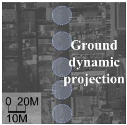 |  | |
| Facade projection of arcade building | Pedestrian road | Traffic, leisure and stay, interaction | Facade projection | Flower pool, landscape sketches | 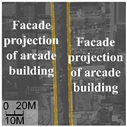 |  | |
| Lights-cape of landscape lighting | Lightscape of the site of the ruins of time-honored Beijing Road and Gongbei Tower | Pedestrian road | Viewing, leisure and stay | Lights under the glass cover, reflective glass, lanterns on the surrounding ancient trees, lights of surrounding buildings | Ancient trees, landscape sketches |  |  |
| Lightscape of Copper Kettle Clepsydra | Intersection | Viewing, leisure and stay, taking photos | Landscape sketch lighting, water lighting | Green plants, waterscape | 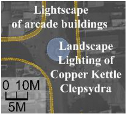 |  | |
| Lightscape of new Flower Street | Pedestrian road | Leisure and stay, business | Landscape sketch lighting, shop lighting, tree lantern lighting | Green plants, flower pool, landscape sketches | 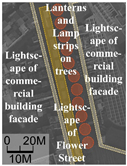 |  | |
| Lightscape Type | Space Type | Function of the Location | Lightscape Elements | Environmental Landscape Elements | Folk Lightscape Distribution Map | Picture |
|---|---|---|---|---|---|---|
| Folk lightscape of “Flower Street” | Square, pedestrian road | Viewing, business, interaction | Lanterns, decorative lighting facade lighting of structures | Green plants, landscape sketches | 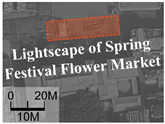 | 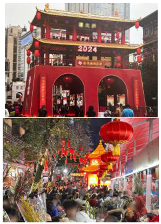 |
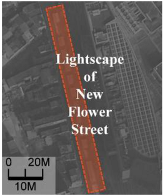 | ||||||
| Guangfu Water Temple Fair | Wharf, waterfront space | Tour, traffic | Lanterns, decorative lighting | Waterscape, urban landscape | 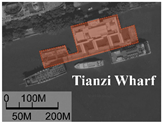 | 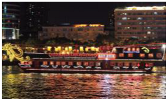 |
| Lightscape Type | Ancient and Modern Lightscape and Its Present Situation | Contemporary New Lightscape | The Vanished Historical Lightscape and the Reason for Disappearance | ||
|---|---|---|---|---|---|
| Natural lightscape | The Pearl River near Tianzi Wharf: sunlight, moonlight, sunset glow, wave light, water light | The north bank of the Pearl River has moved southward, but its natural lightscape still exists | Lightscape of the site of the ruins of time-honored Beijing Road and Gongbei Tower | Enjoying “Hai Shan Xiao Ji” in Haishan Tower, watching the tide, reviewing the navy (Song Dynasty (960–1276)) sword and gun reflect the sun | Haishan Tower was destroyed by war in Yuan Dynasty (1271–1368) |
| West Lake and Yaozhou site: Natural water light, water reflection, tree light and shadow | The area of West Lake and Yaozhou has been reduced, and now there is only the site of “Nine Star Garden”; Some natural lightscapes still exist | “Taiping Yanhu” is formed due to the hazy water vapor in sandbars | The north bank of the Pearl River moves southward, and sandbars merge into the north bank | ||
| Light and shadow of arcade buildings | The arcade of the building is intact, and the light and shadow changes still exist | West Lake and Yaozhou: lotus shadow, dense Sea Island, cloud shadow in the water, mirage of pavilions, solitary smoke under the sunset and “The Spring Sunrise of Yaozhou” | The diversion of the water system led to the shrinkage of the lake. There is only one pond left after the Qing Dynasty (1644–1912), which is now the “Yaozhou site” | ||
| Artificial lightscape | All kinds of lanterns and lamps | The form and function have changed with the changes in the times | Lightscape of building lighting: Lights of the Grand Buddha Monastery at night, facade lighting and lighting show of Department of Finance of Guangdong Province Building, lighting of arcade facade at night | Jasmine lantern, lightscape of flower lights in the jasmine flower market at South Gate | Jasmine flowers are reduced due to the introduction of exotic flowers |
| Multimedia technology: Xin Da Xin Department Store naked eye 3D curved screen, holographic dynamic projection on the ground, facade projection of arcade building | Glass lamps and lanterns shops in Shuangmendi and the Grand Buddha Monastery | Changes in products and business models due to changes in the times | |||
| Lightscape of flower market | It has moved to the West Lake Road area and evolved into the current lightscape of the Spring Festival Flower Market | Lightscape of landscape lighting: lighting of the site of the ruins of time-honored Beijing Road and Gongbei Tower, lightscape of Copper Kettle Clepsydra, flower street lighting | Lightscape of night market on West Lake Road | Canceled | |
| Lightscape of Lujiang Academy | The academy is now used for other purposes | ||||
| Lightscape of official activities at Tianzi Wharf | Official activities no longer exist | ||||
| Folk lightscape | Folk lightscape of “Flower Street” | The folk custom of “Flower Street” has been handed down to this day | Lightscape of the Guangfu Water Temple Fair at Tianzi Wharf | The light shed of Haishan Tower flickers | Haishan Tower was destroyed by war in Yuan Dynasty (1271–1368) |
| The lightscape of dragon boat race in the Dragon Boat Festival | The location of the Dragon Boat Race has been transferred from West Lake to the Pearl River and has been handed down to this day | Birthday of the Lord Huaguang in Shuangmendi: the lamps were painted with colors, the lights were brilliant | It was banned by the government at the end of Daoguang. This folk custom has declined and disappeared | ||
| Guangfu Temple Fair | It is now an official- led folk festival with a modern lantern festival | ||||
Disclaimer/Publisher’s Note: The statements, opinions and data contained in all publications are solely those of the individual author(s) and contributor(s) and not of MDPI and/or the editor(s). MDPI and/or the editor(s) disclaim responsibility for any injury to people or property resulting from any ideas, methods, instructions or products referred to in the content. |
© 2025 by the authors. Licensee MDPI, Basel, Switzerland. This article is an open access article distributed under the terms and conditions of the Creative Commons Attribution (CC BY) license (https://creativecommons.org/licenses/by/4.0/).
Share and Cite
Qiu, J.; Cai, W.; Song, J.; Zhang, H.; Li, Y. A Study on the Evolution of Lightscapes in the Beijing Road Historic and Cultural Zone, Guangzhou, China. Buildings 2025, 15, 3636. https://doi.org/10.3390/buildings15203636
Qiu J, Cai W, Song J, Zhang H, Li Y. A Study on the Evolution of Lightscapes in the Beijing Road Historic and Cultural Zone, Guangzhou, China. Buildings. 2025; 15(20):3636. https://doi.org/10.3390/buildings15203636
Chicago/Turabian StyleQiu, Jianzhen, Weimei Cai, Jinyu Song, Honghu Zhang, and Yating Li. 2025. "A Study on the Evolution of Lightscapes in the Beijing Road Historic and Cultural Zone, Guangzhou, China" Buildings 15, no. 20: 3636. https://doi.org/10.3390/buildings15203636
APA StyleQiu, J., Cai, W., Song, J., Zhang, H., & Li, Y. (2025). A Study on the Evolution of Lightscapes in the Beijing Road Historic and Cultural Zone, Guangzhou, China. Buildings, 15(20), 3636. https://doi.org/10.3390/buildings15203636





